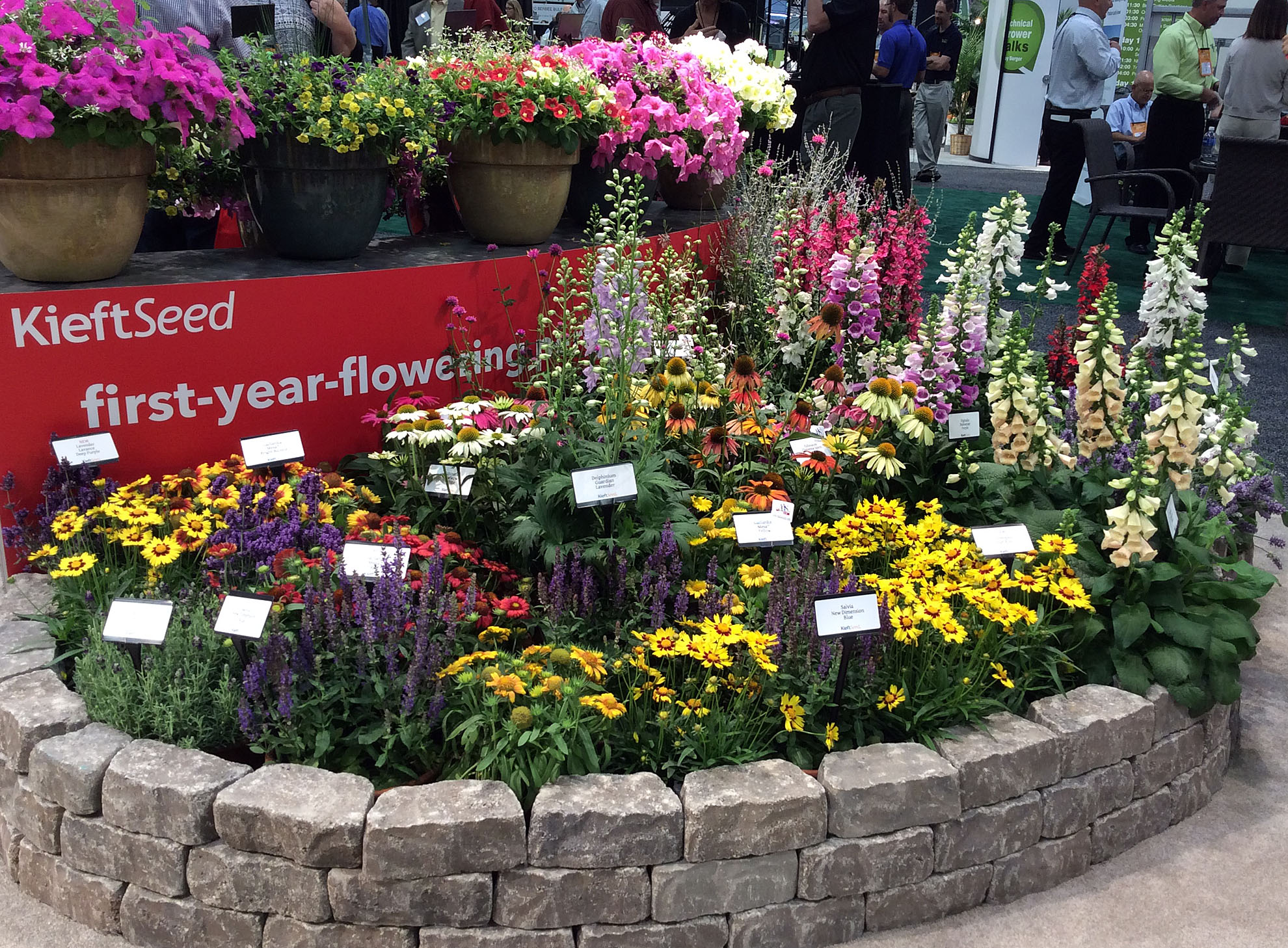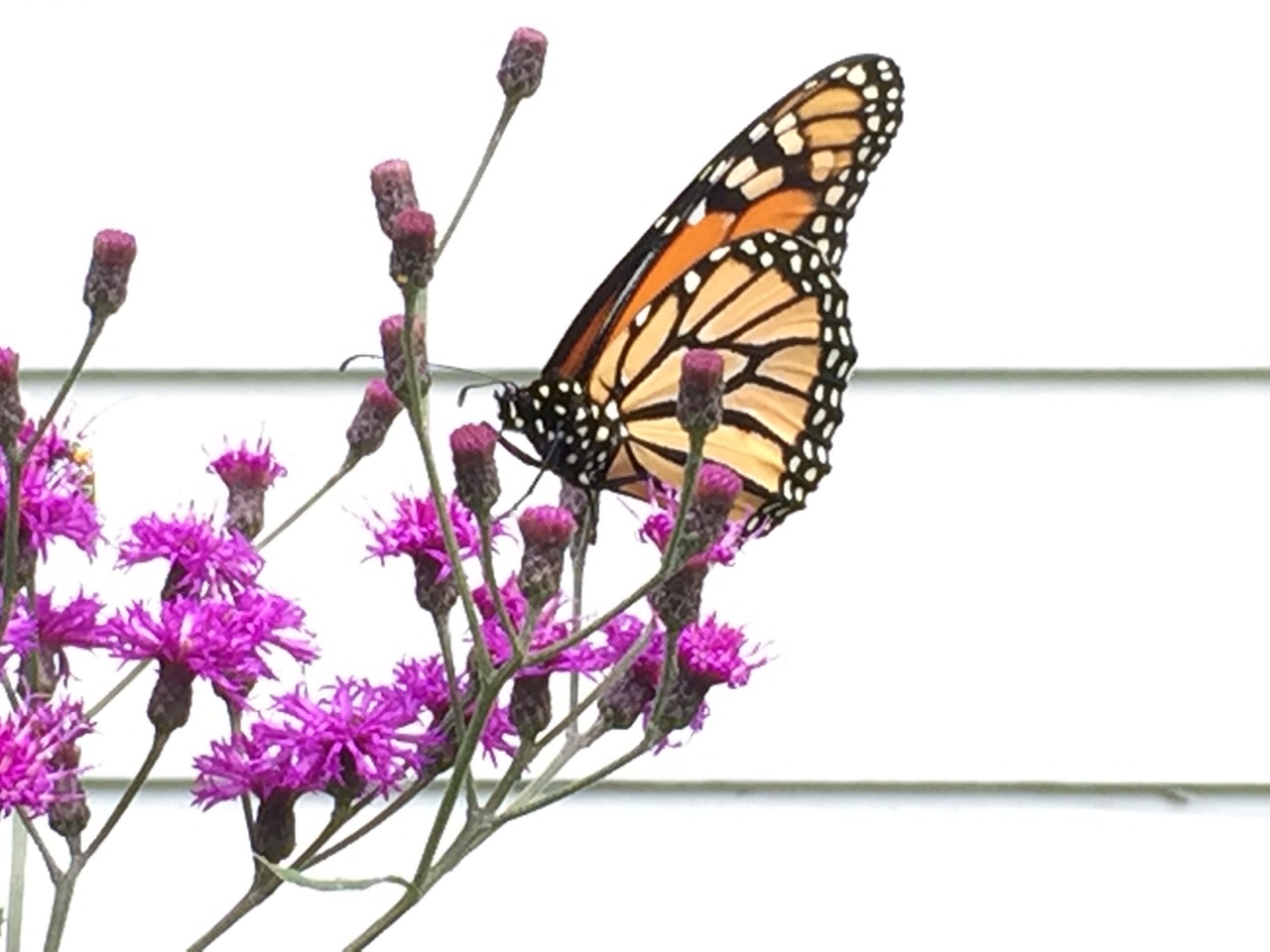by GardenLover | Jan 11, 2017 | Favorite Flora, Garden profile
Low-Profile, High-Impact Moss Enlivens the Backyard in Winter
By Michael Leach
The other evergreens get all the attention. It’s not surprising. From spruces to firs to boxwood most evergreens are big, in-your-face plants. Only in their youngest years might they be overlooked in the winter scene.
Little wonder that moss (and lichens to an extent) are the unsung evergreens. Besides spring green, they add various shades, including rust, ochre and blue-gray, to my landscape. Seemingly as inconsequential as a pinch of nutmeg, theirs is a welcome dash of piquancy bringing vibrancy to this dreary season.
I’ve always been partial to moss. For one thing, this plant is pet-able. While not quite as inviting as lamb’s ear, the velvety surface is hard to resist. Moss appeals, too, because it instantly adds a sense of permanence and venerable elegance to whatever it chooses to grow on. This is especially useful in the landscape surrounding the family home place, a small Victorian farmhouse.
Moss grows on many surfaces in my rather shady garden. Besides the damp and dim places in the lawn, where even weeds are reluctant to take hold, moss appears on stones, brick pavements, tree trunks, driveway gravel, old concrete walls and a section of garage roof.
(Perhaps something should be done about the roof, as the growth no doubt holds dampness against the shingles)
However, it wasn’t until a stroll through my garden on a mild winter day that I began to appreciate moss for its winter interest. Here and there were welcome signs of life. Tufts and miniature “lawns” of sprightly moss glowed in the sun.
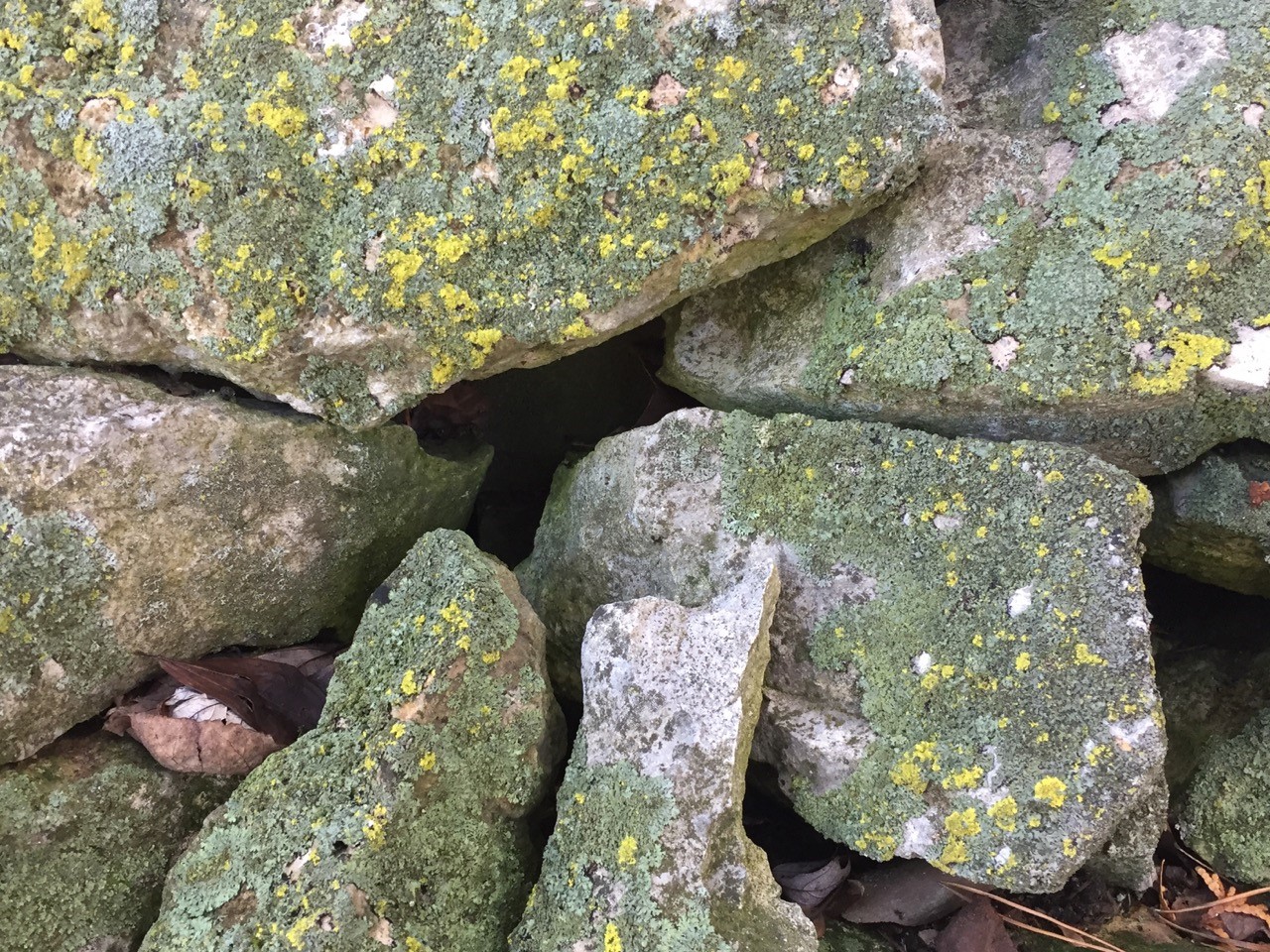
The low stone wall wears a light coat of a gray-blue lichen, nature’s version of the verdigris found on old copper roofs. Such an elegant way to soften the stones and add subtle color.
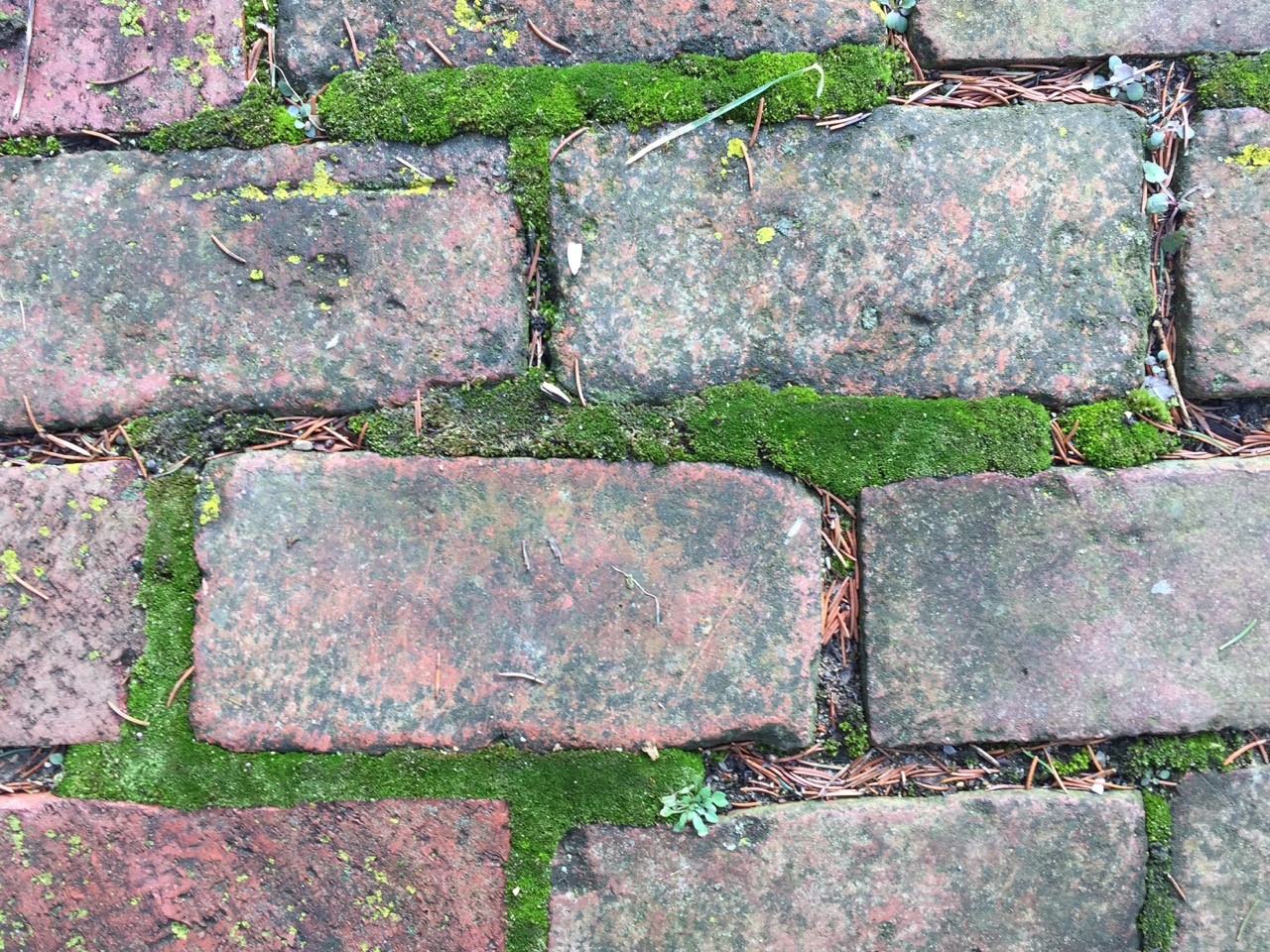
Moss is a “mortar” that gives the brick walk a vintage look. (Caution is a must when walking on wet bricks and moss).
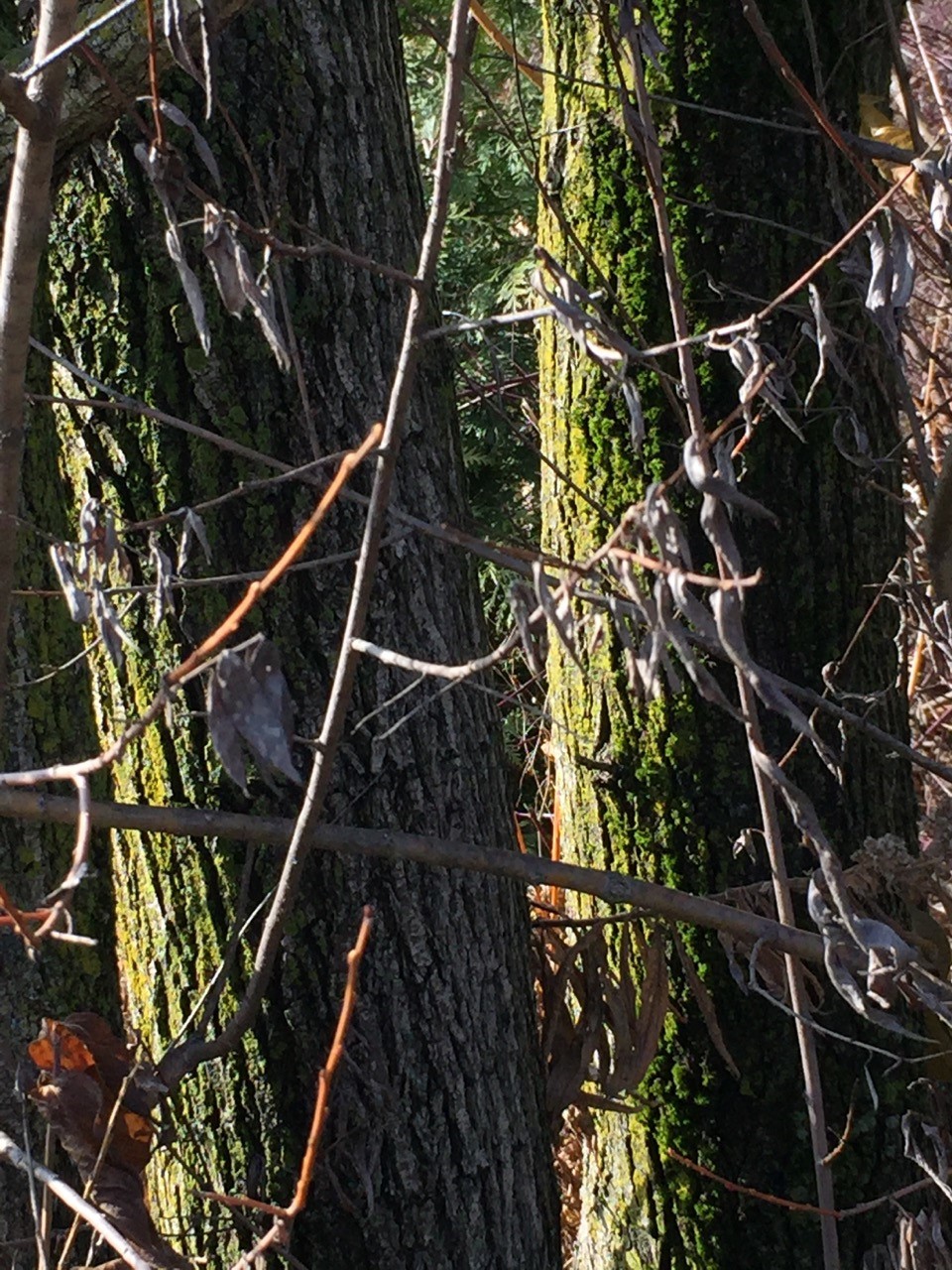
If there’s sufficient moisture, moss and lichens grow on the south side of trees, too.
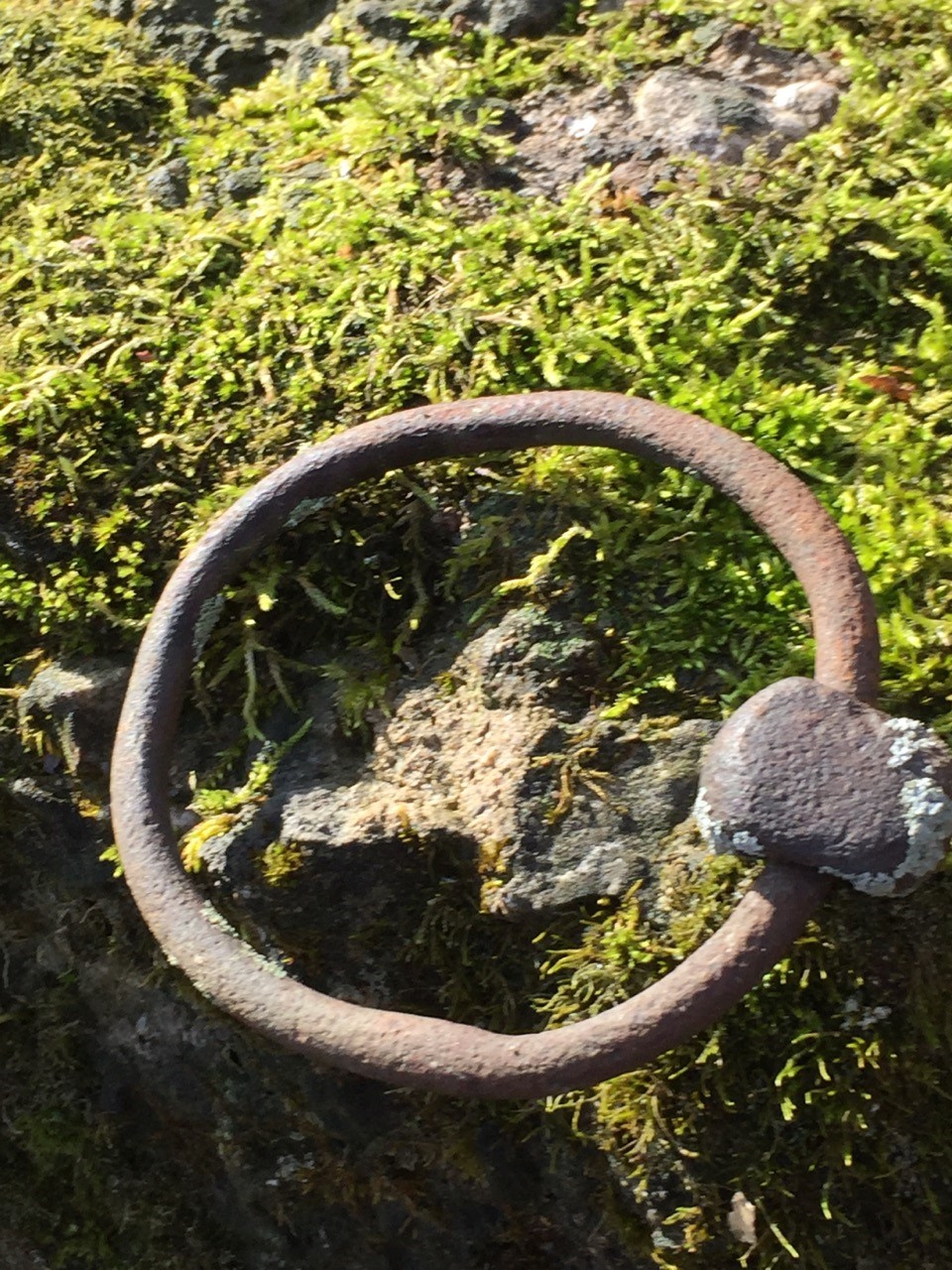
A hitching ring on the old concrete horse watering trough rests atop a soft carpet of moss.
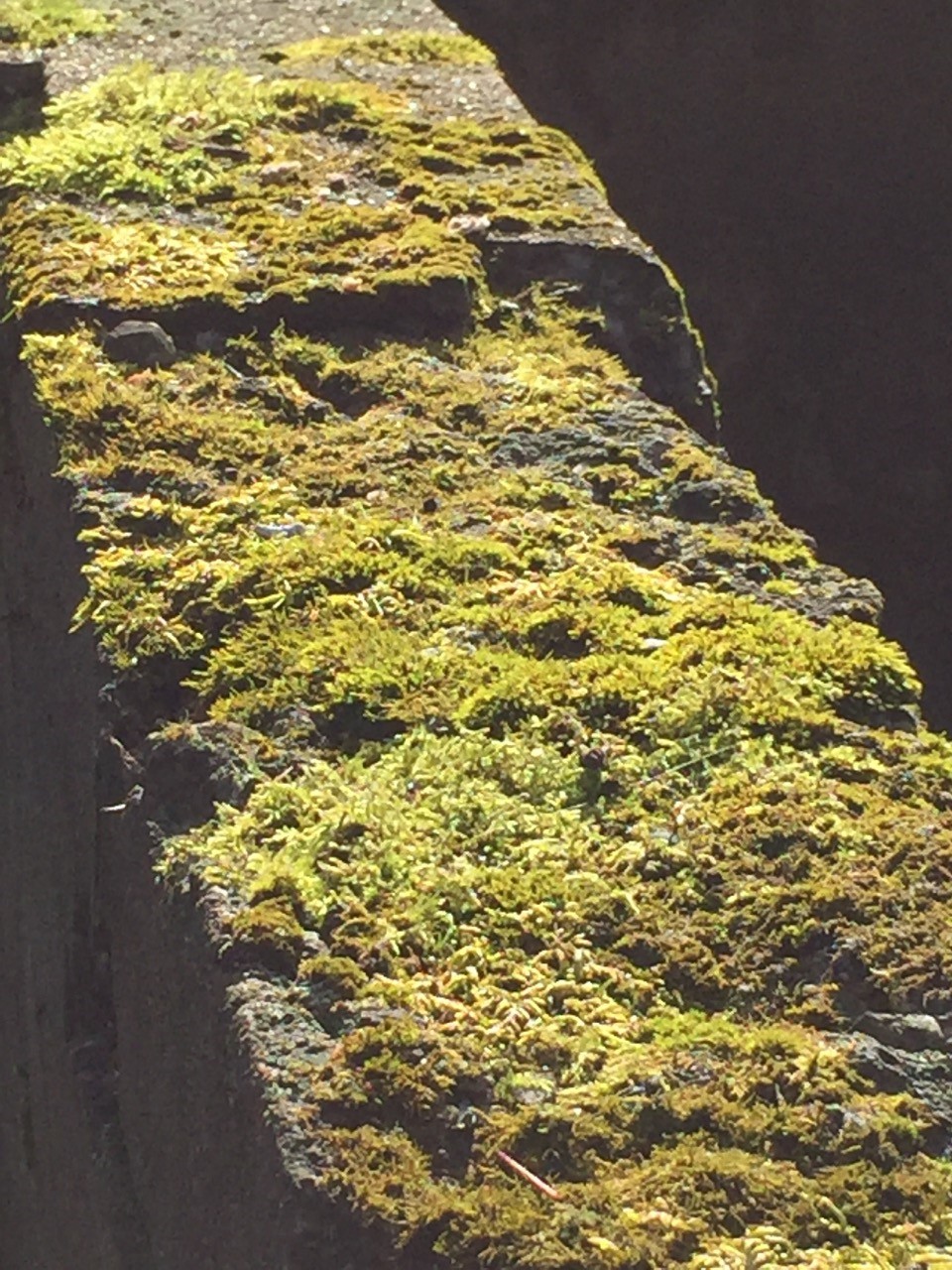
A moss “lawn” adds a touch of antiquity to the crumbling concrete walls of a late 19th century watering trough. The greenery took up residence a few years ago.
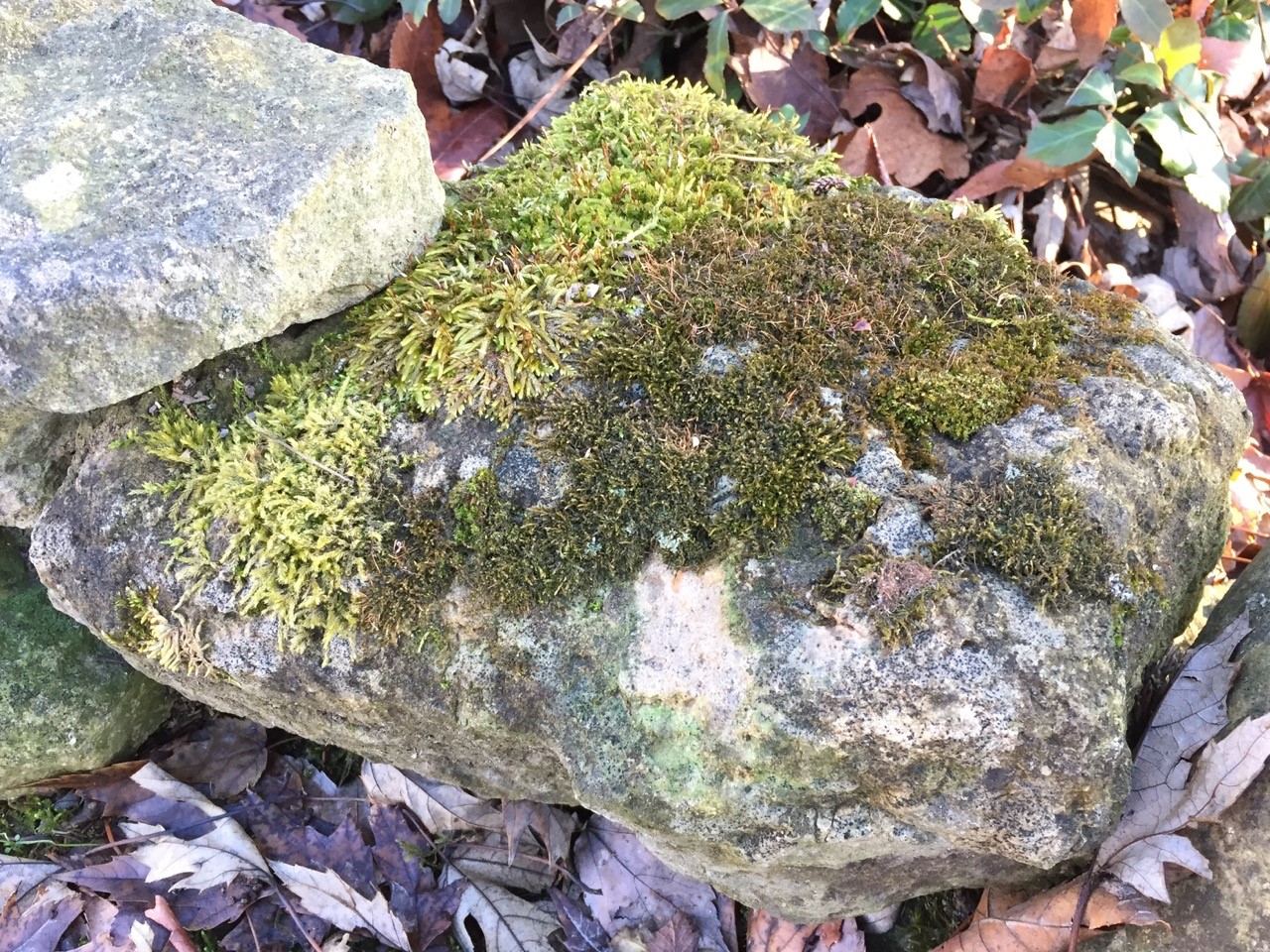
Why moss grows where it does is a mystery to me. Like most other volunteers in the garden, I allow it to live where it likes. (Maybe the stone on the left rolls.)
Learn more about mosses:
Moss sources:
by GardenLover | Sep 9, 2016 | Favorite Flora, Trendspotting
Professional Conferences and Trade Shows = More Plants, People and Gardens
By Debra Knapke
I have been attending the Annual Symposium of the Perennial Plant Association since 1992. This conference is held in different locations in the United States and Canada. It combines education sessions and tours geared toward designers, growers and retailers for whom herbaceous perennials are a part of their business focus. I have visited many prestigious Botanical Gardens and Arboretums and countless private gardens that are not often open to the public. This year, I travelled to Minneapolis, and this was the best yet (I say this, every year).
Below is a very small sample (out of 110 images) of what I experienced in early August.
Plants, Plants and more Plants
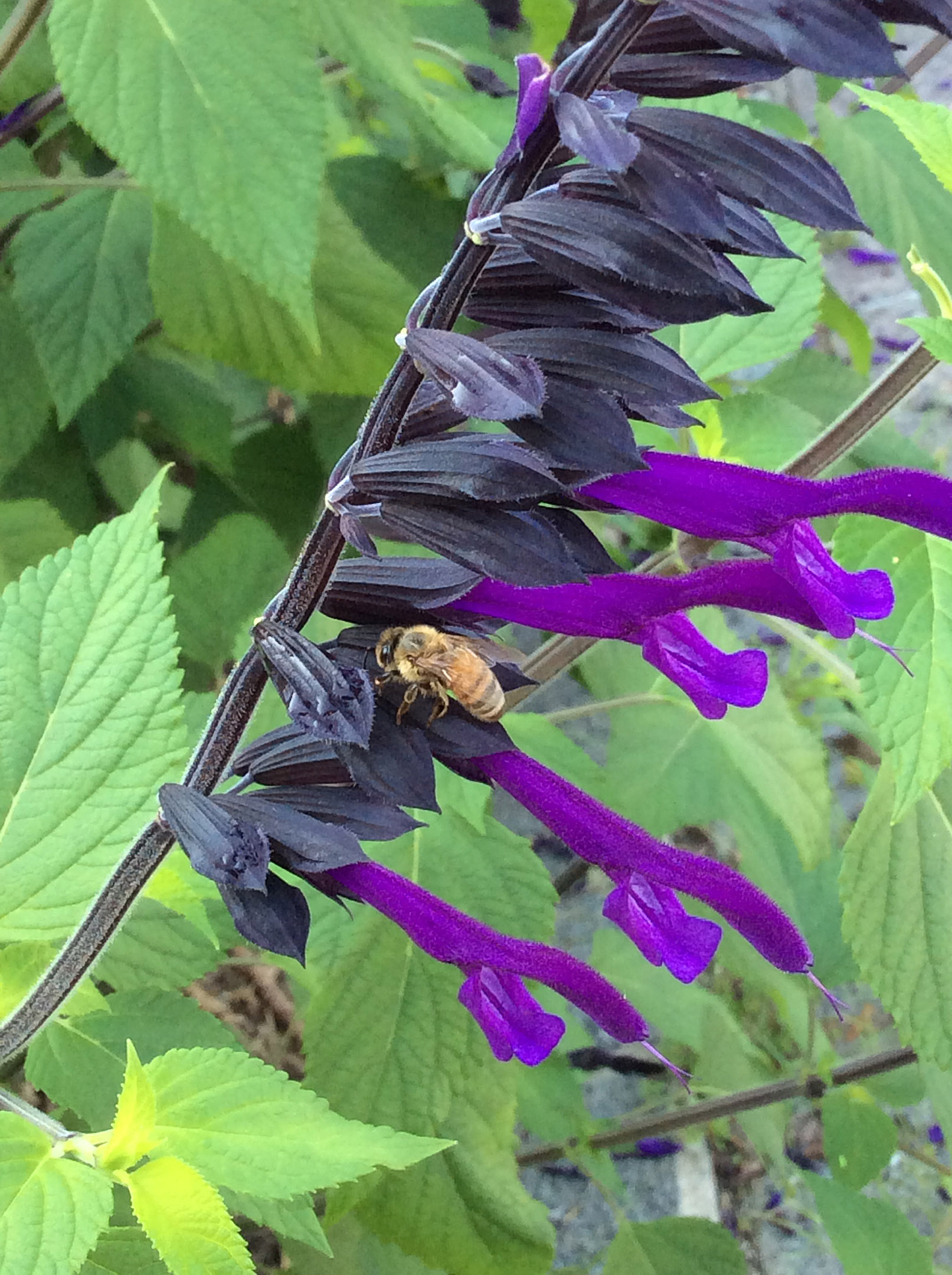 Sages are among my favorite plants: gorgeous flowers, hummingbird and other pollinator attractors, herbal uses, and easy to grow. Above is one of the Brazilian sage species (Salvia guaranitica ‘Amistadt’). Its electric purple blooms call you from across the garden. An older sibling (below) is Black and Blue sage (Salvia guaranitica ‘Black and Blue’). When you grow this sage in your garden be prepared to be strafed by hummingbirds if you happen to be weeding when they wish to feed.
Sages are among my favorite plants: gorgeous flowers, hummingbird and other pollinator attractors, herbal uses, and easy to grow. Above is one of the Brazilian sage species (Salvia guaranitica ‘Amistadt’). Its electric purple blooms call you from across the garden. An older sibling (below) is Black and Blue sage (Salvia guaranitica ‘Black and Blue’). When you grow this sage in your garden be prepared to be strafed by hummingbirds if you happen to be weeding when they wish to feed.
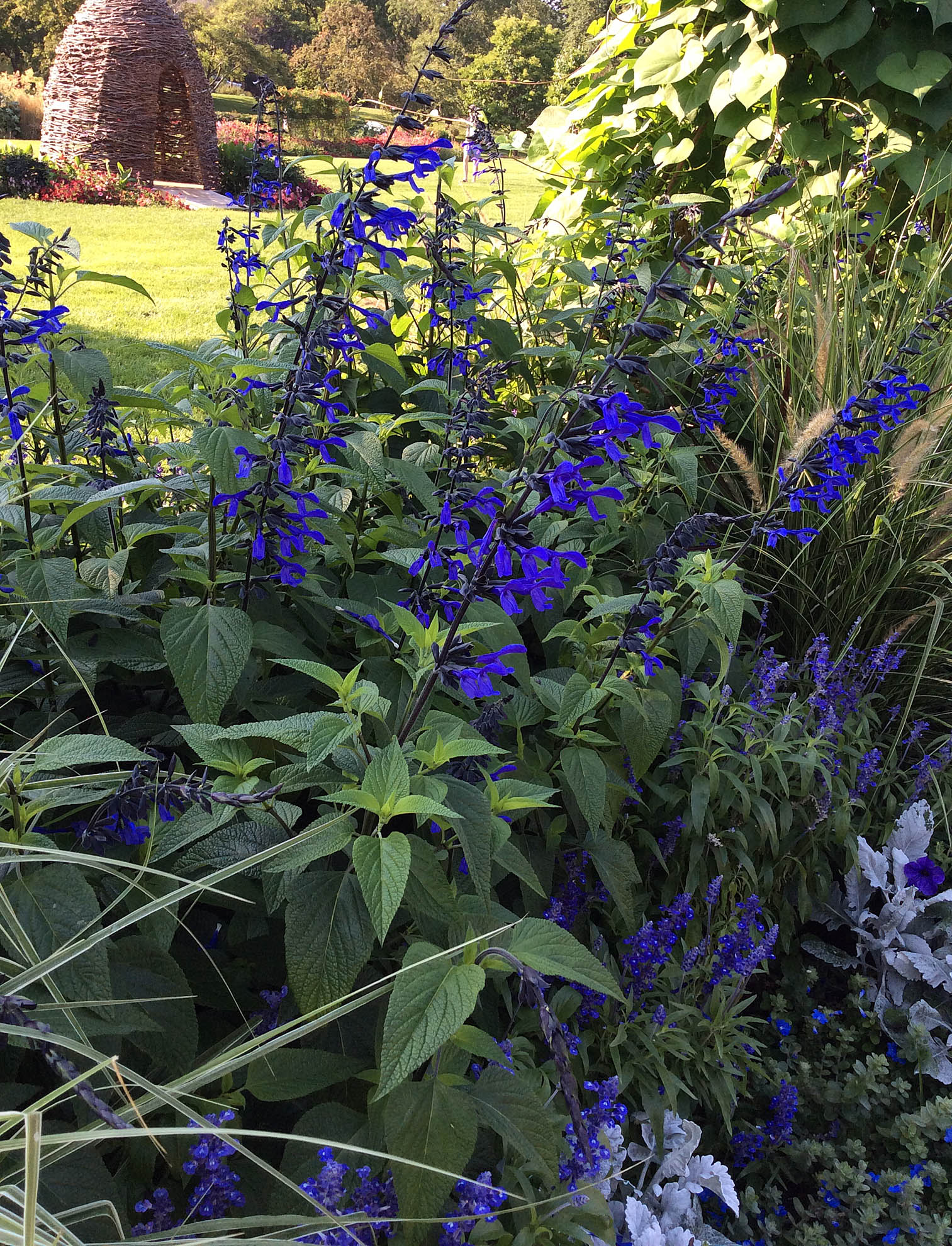
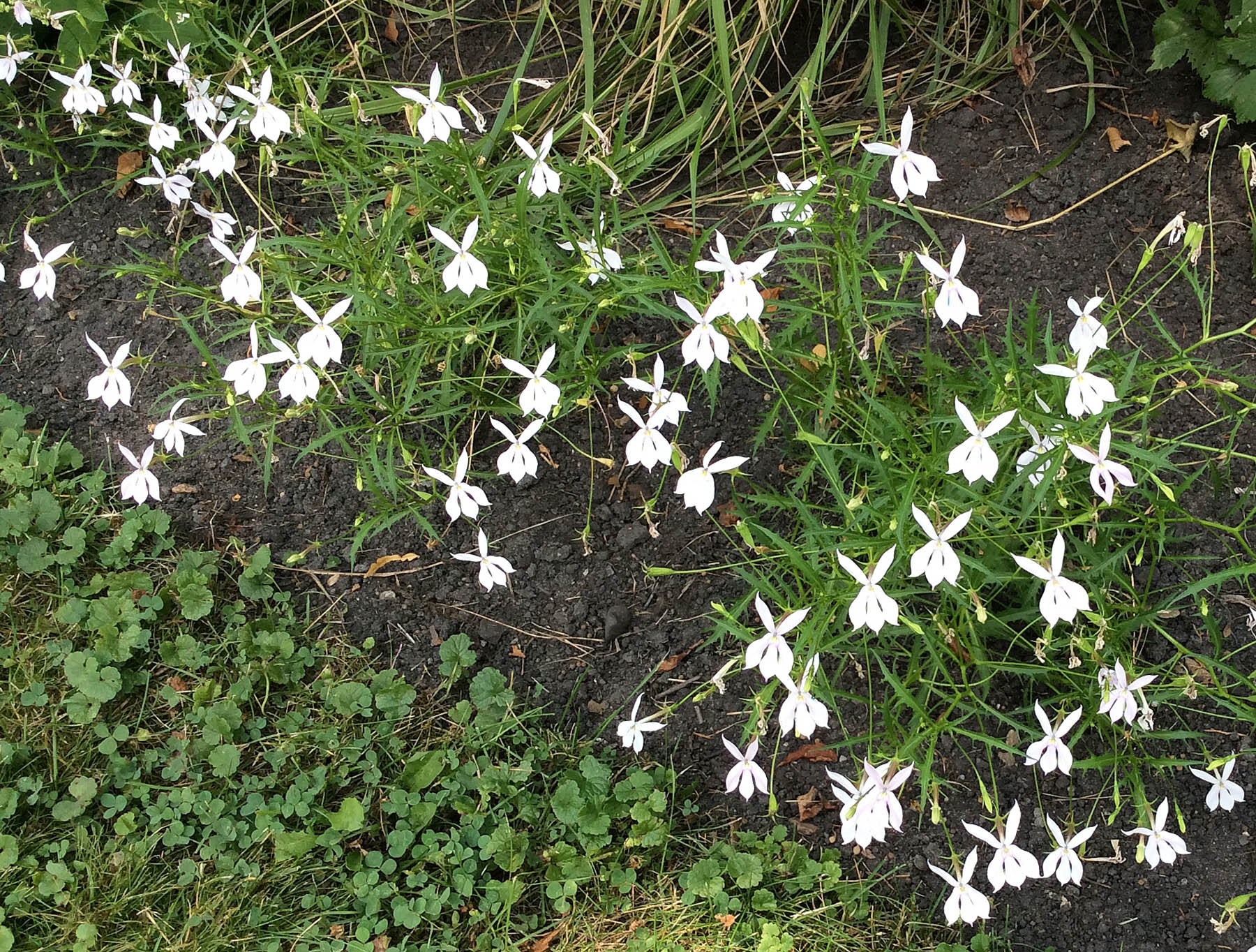 From time the time, the experts are stumped. This lovely little annual had many of us asking: “What is this?” When we found a docent who had the plant list and learned that we were looking at a large-flowered laurentia (Isotoma axillaris ‘Avant Garde White’), there were more than a few sheepish expressions. The flowers were approximately 1.5” in diameter – they are usually much smaller – and they danced in the breeze. And, another plant goes on the list for next year!
From time the time, the experts are stumped. This lovely little annual had many of us asking: “What is this?” When we found a docent who had the plant list and learned that we were looking at a large-flowered laurentia (Isotoma axillaris ‘Avant Garde White’), there were more than a few sheepish expressions. The flowers were approximately 1.5” in diameter – they are usually much smaller – and they danced in the breeze. And, another plant goes on the list for next year!
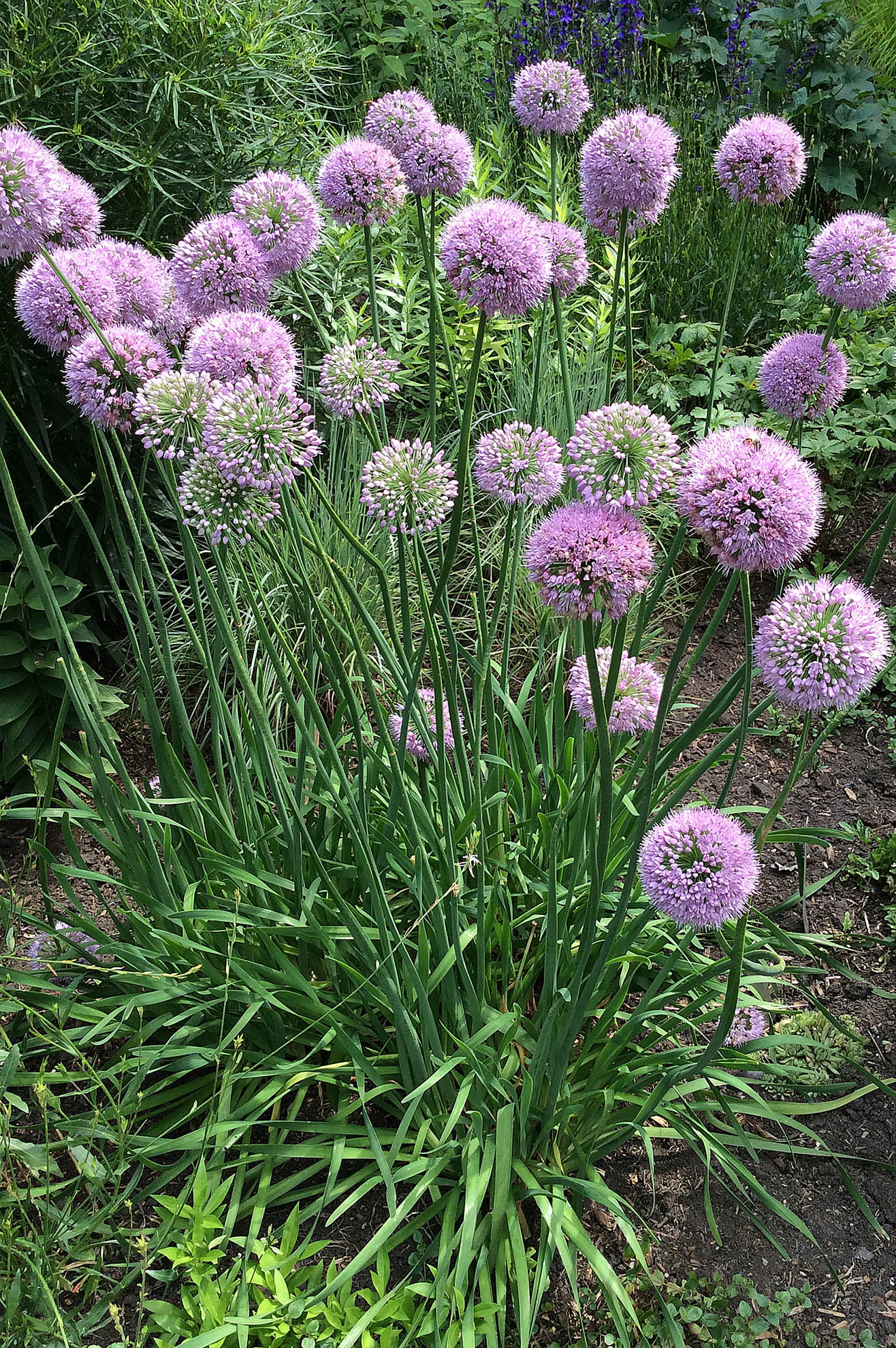 Alliums are another useful plant in the garden. One downside is their excessive seeding. After three to four years, you may have only alliums in your garden. Enter some of the new hybrids that make few to no fertile seeds. Pink Planet allium (above) is one of those new hybrids; Millennium is another – Millennium allium is now in my garden. I will let you know about its fecundity.
Alliums are another useful plant in the garden. One downside is their excessive seeding. After three to four years, you may have only alliums in your garden. Enter some of the new hybrids that make few to no fertile seeds. Pink Planet allium (above) is one of those new hybrids; Millennium is another – Millennium allium is now in my garden. I will let you know about its fecundity.
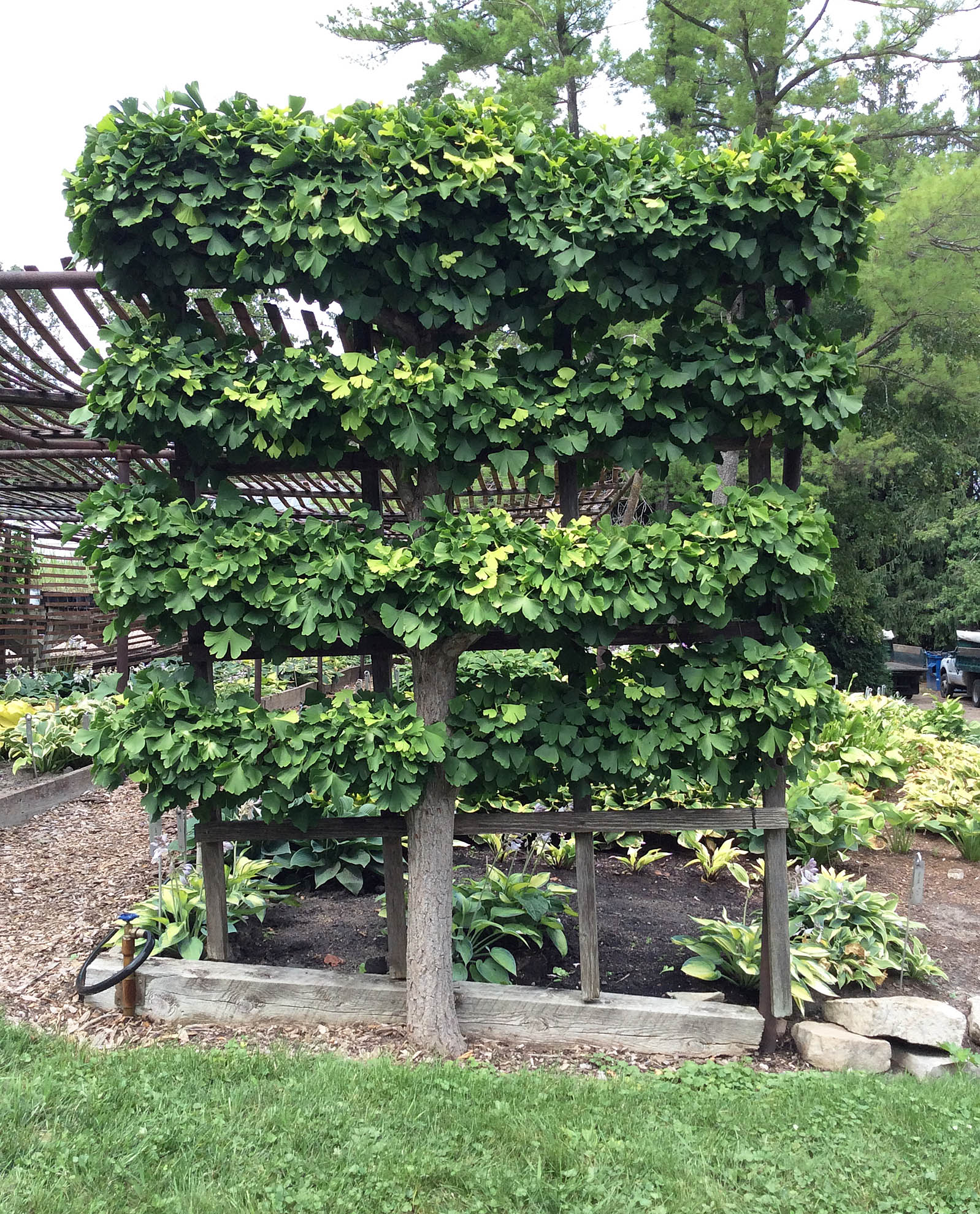 At Kelly and Kelly Nursery, we saw what patience and vision can achieve. Need a fence? Create a ginkgo espalier. If you start this project now, you can have this in 10 to 15 years, or so.
At Kelly and Kelly Nursery, we saw what patience and vision can achieve. Need a fence? Create a ginkgo espalier. If you start this project now, you can have this in 10 to 15 years, or so.
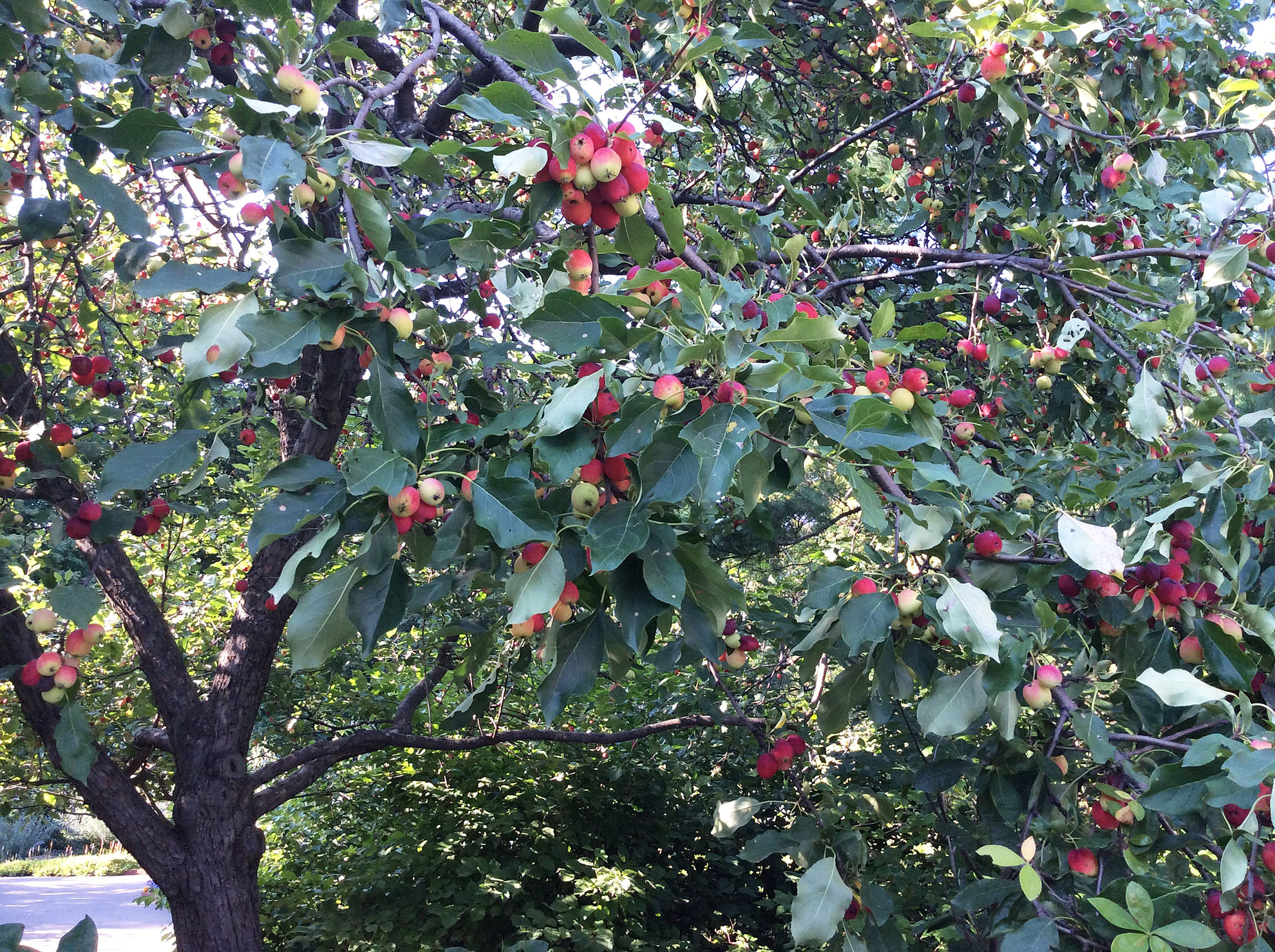 I would be remiss if I didn’t include a picture from the edible garden at the Minnesota Landscape Arboretum. If you are looking for the tastiest crabapple for jams and jellies then Dolgo crabapple (Malus ‘Dolgo’) is your tree. What is the only difference between a crabapple and an apple? The diameter of a crabapple is two inches or less; an apple is larger than two inches.
I would be remiss if I didn’t include a picture from the edible garden at the Minnesota Landscape Arboretum. If you are looking for the tastiest crabapple for jams and jellies then Dolgo crabapple (Malus ‘Dolgo’) is your tree. What is the only difference between a crabapple and an apple? The diameter of a crabapple is two inches or less; an apple is larger than two inches.
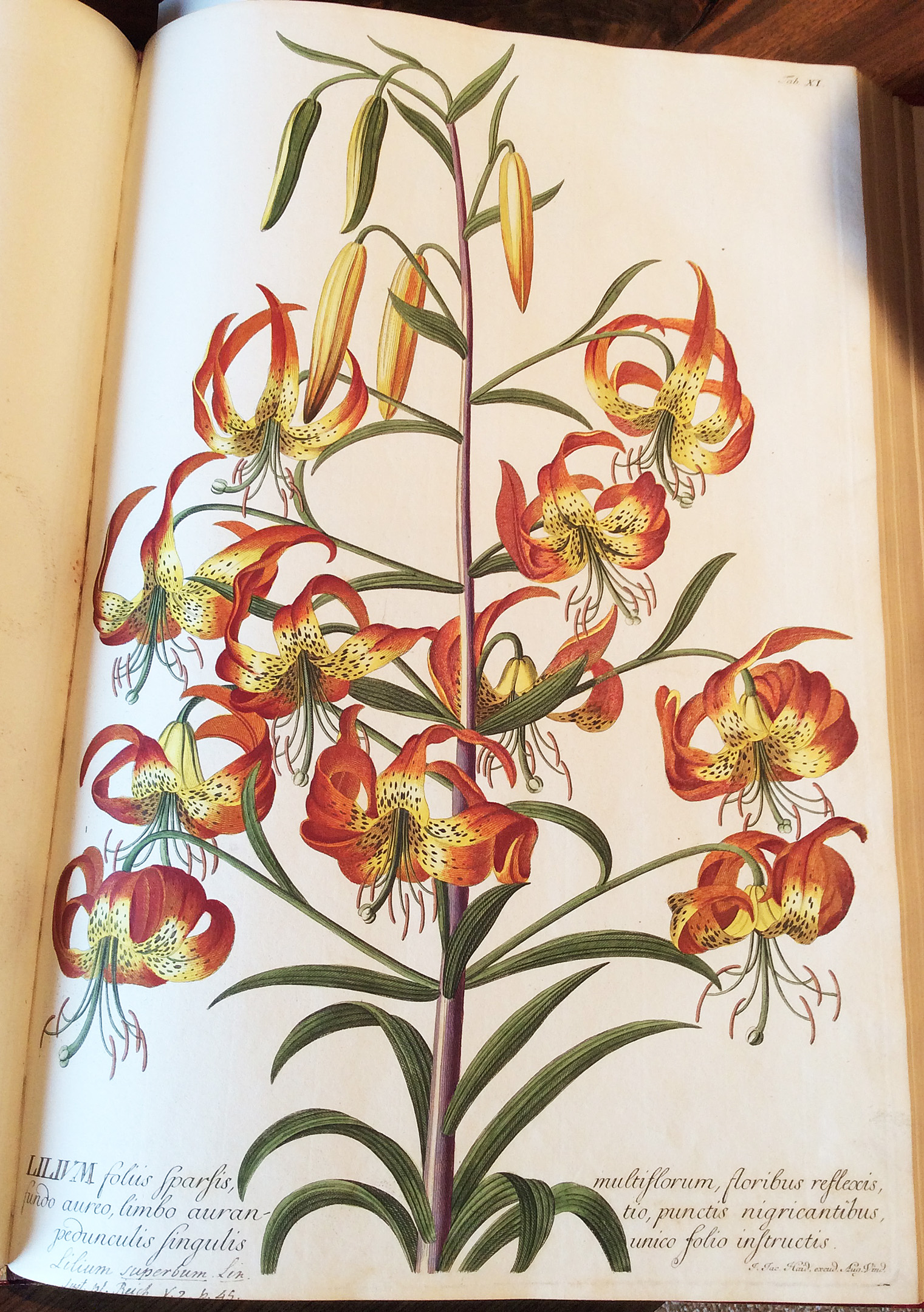 Not all of the plants we see are in pots or gardens. The Minnesota Landscape Arboretum has an extensive collection of rare books in its library. This gorgeous lily was hand-colored and sold in limited folios to those who could afford books back in 1542 — 50 years after Columbus sailed the ocean blue. (De Historia Stirpium, Leonhart Fuchs, 1542)
Not all of the plants we see are in pots or gardens. The Minnesota Landscape Arboretum has an extensive collection of rare books in its library. This gorgeous lily was hand-colored and sold in limited folios to those who could afford books back in 1542 — 50 years after Columbus sailed the ocean blue. (De Historia Stirpium, Leonhart Fuchs, 1542)
Design!
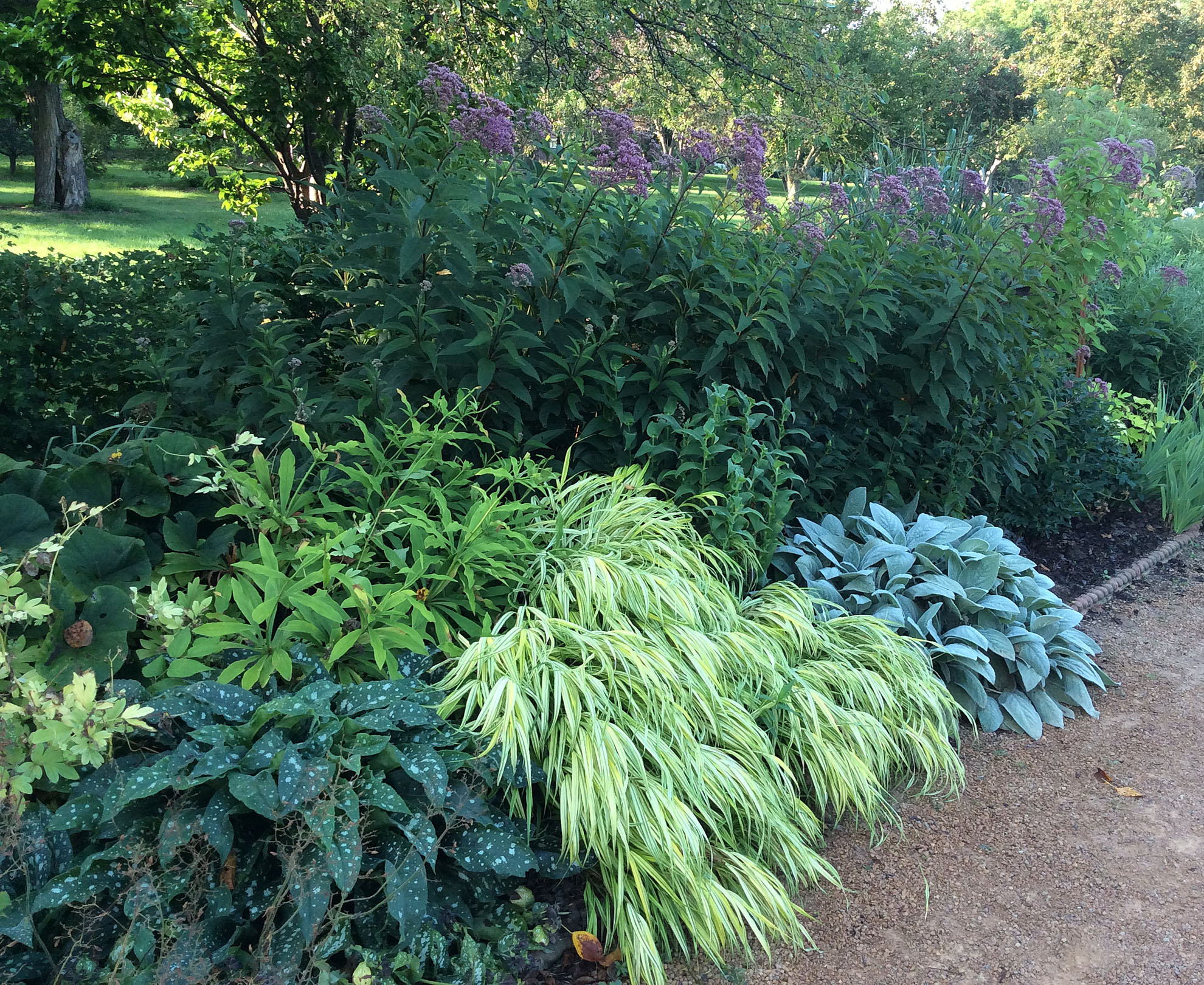 Plants are the designer’s medium. We use the tools of line, form, texture and color to create borders, beds and vignettes. We make places of order, activity, privacy and repose. Here is a border that is peaceful and textural in nature.
Plants are the designer’s medium. We use the tools of line, form, texture and color to create borders, beds and vignettes. We make places of order, activity, privacy and repose. Here is a border that is peaceful and textural in nature.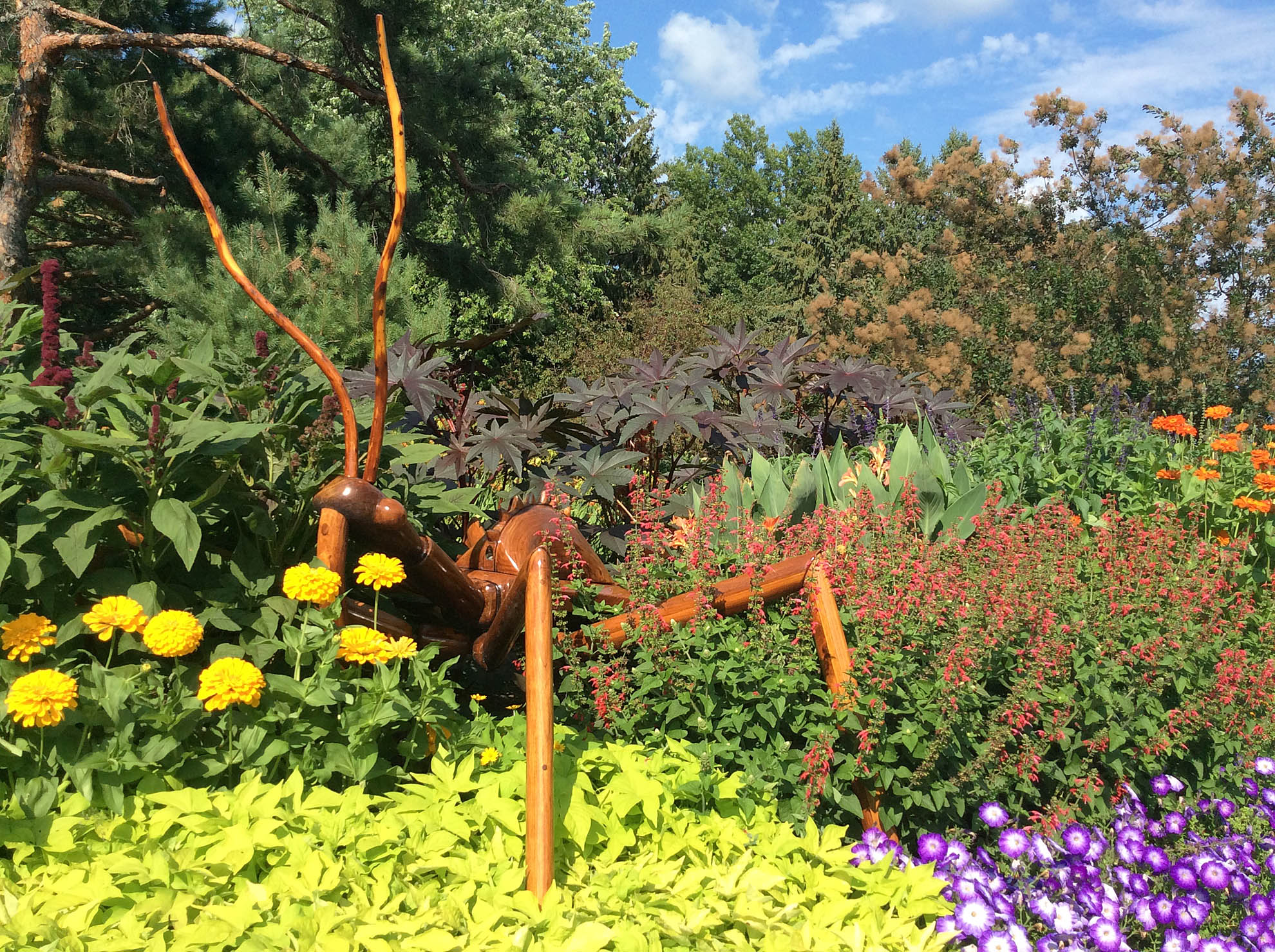
… while this border is a riot of hot colors. It also happens to be complimented by a “Big Bug” assassin bug.
Speaking of insects: bee hotels have been making appearances in all the best gardens. I’ve seen recommendations for creating tubes from paper or thin cardboard. If you look closely, you can see that all of the materials in the houses are from the garden: small drilled branches and herbaceous plant stems that are usually relegated to the compost pile. Here are two versions — a multi-level hotel and a simple bee hostal.
Coda
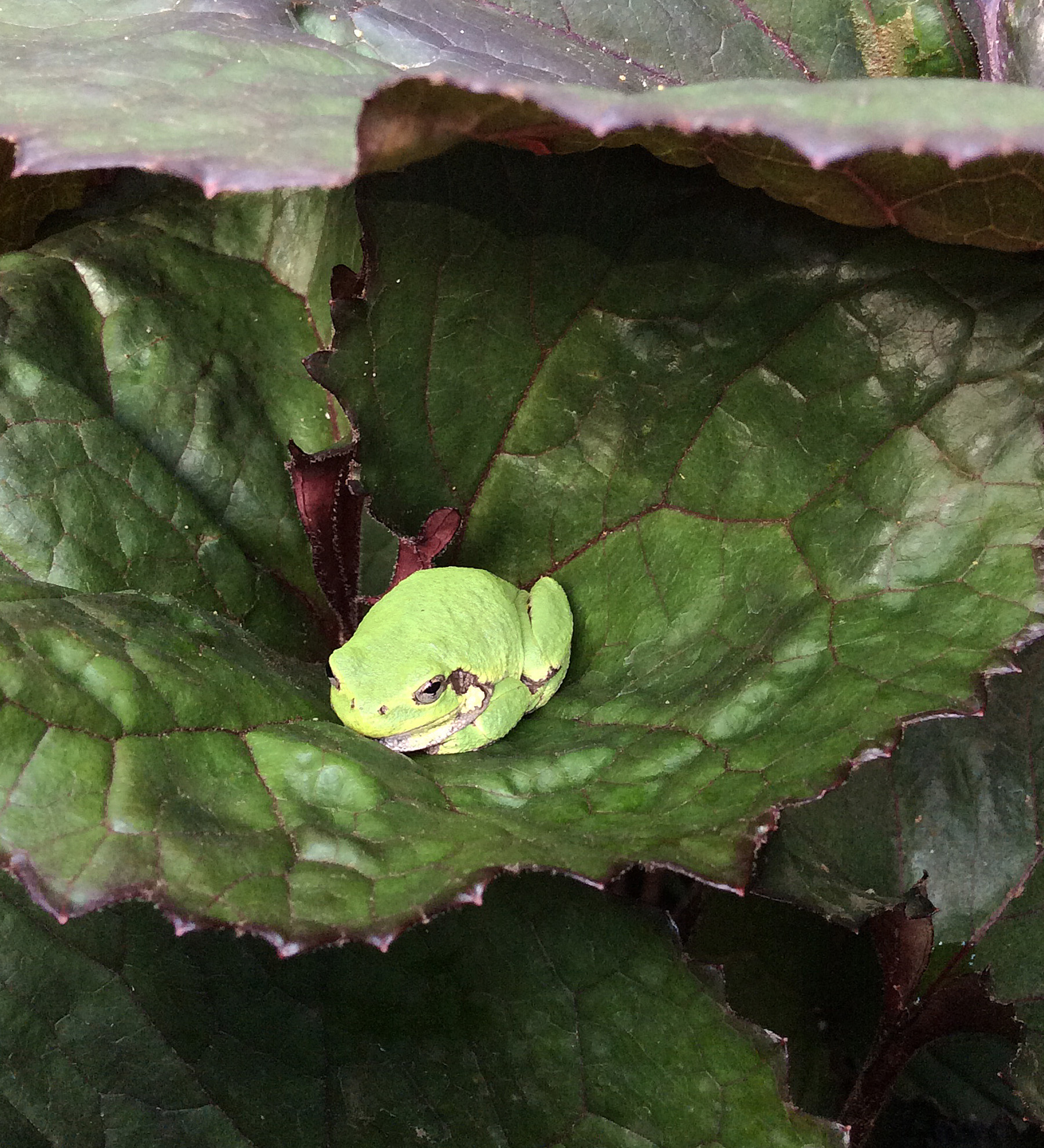 Being a plant addict is not a hopeless condition. There are times when something other than a plant grabs my attention. This green tree frog nestled in a ligularia leaf may have been one of the most photographed garden visitors on the garden tour. Of course we were discussing the perfect color harmony of the reddish-brown markings on the frog with the veins on the leaf. Get a bunch of designers together and what do you get? Endless discussions of color, form and texture in the garden!
Being a plant addict is not a hopeless condition. There are times when something other than a plant grabs my attention. This green tree frog nestled in a ligularia leaf may have been one of the most photographed garden visitors on the garden tour. Of course we were discussing the perfect color harmony of the reddish-brown markings on the frog with the veins on the leaf. Get a bunch of designers together and what do you get? Endless discussions of color, form and texture in the garden!
Wishing you a beautiful fall!
by GardenLover | Aug 30, 2016 | Favorite Flora, Happenings, Special Topic
Professional Conferences and Trade Shows = Plants, People and Gardens
By Debra Knapke
One of the joys of my profession is being surrounded by plants. Discovery of “new” plants is a main occupation at the professional meetings and tradeshows that I attend throughout the year. These meetings are filled with anticipation, excitement, revelation, and, for lack of a better word: plant lust.
Two recent conferences re-affirmed my third choice of career in horticulture. In July, Columbus, Ohio hosts Cultivate. This four-day event, organized by
AmericanHort, is the largest Horticulture-Greenhouse-Landscape Trade Show and Educational Short Course in the United States. It offers an international assemblage of companies and an amazing array of plants and products. I take lots of pictures and notes to remind myself of what I want to use in my courses and design work, and what must be tried this year or next.
Below is a very small sample (out of 89 images) of the variety of what I saw in June.
Strange Plants for Special Situations;
Imagine rows and rows of tables holding new plants for 2016. There is something for everyone! Many were snapping pictures of the above spiny specimen. Dyckias (Dyckia brevifolia) look like they are either from outer space or from the deep ocean. They require lean and dry soils and will “melt” during an extended wet spell. Last year and this year my plants had to return to the greenhouse during our rainy spells.
All I could think was –The bold puckered leaves and deep maroon inflorescences of Dracula celosia are just begging to be combined with a fine to medium silver foliaged plant. Not usually an admirer of celosia, I realized that I was feeling a bit of plant lust for this audacious annual. Dracula will be in one of my containers next year; possibly with dusty miller or one of the silvery helichrysums (Helichysum petiolare).
A Beautiful Blender
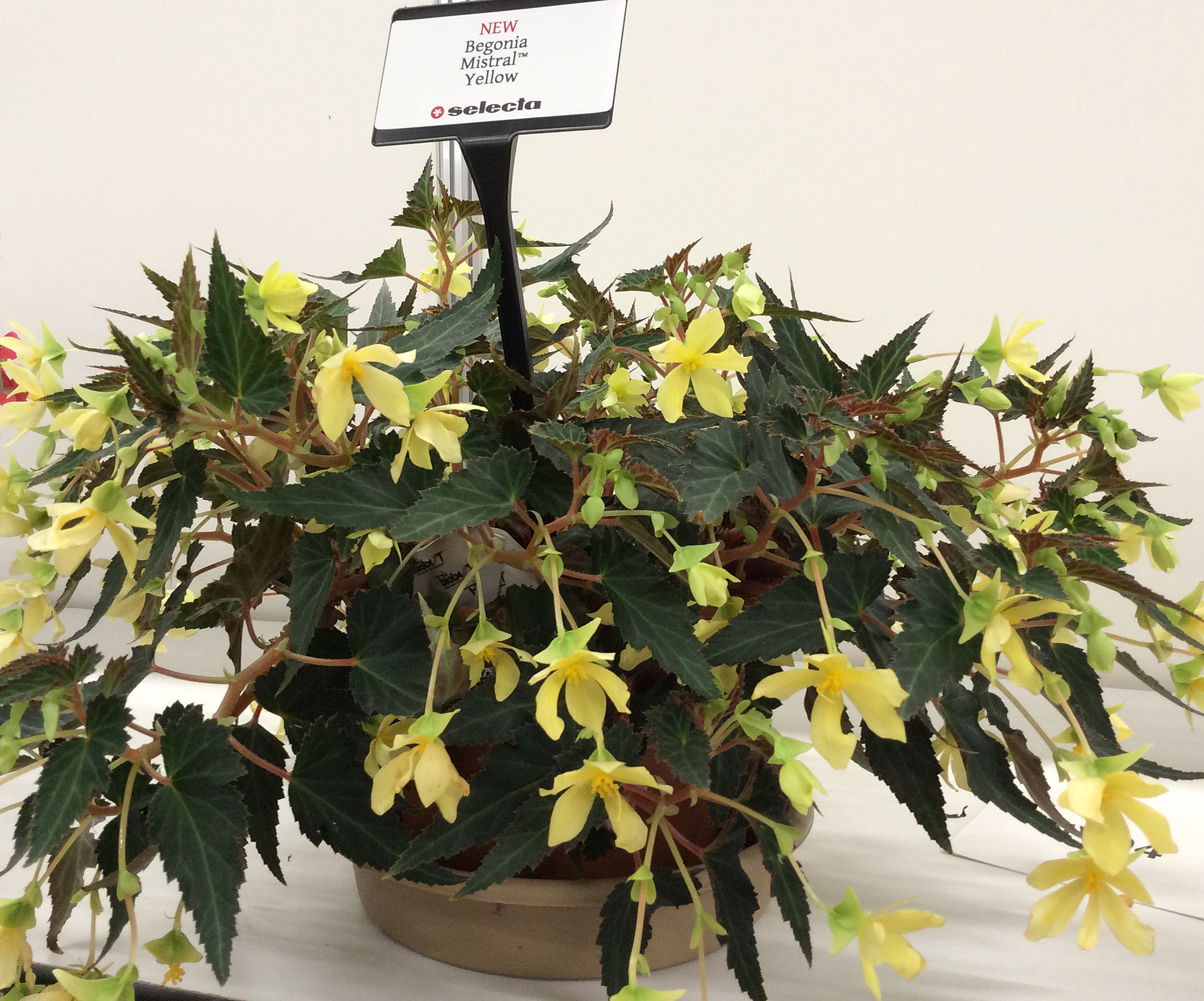
Soft yellow flowers combined with dark green to maroon foliage placed in part to medium shade is like a breath of cool air similar to the winter wind that this plant was named for: Mistral Yellow begonia. I am currently growing the orange selection in my garden; next year I will grow yellow.
Plants in Combination
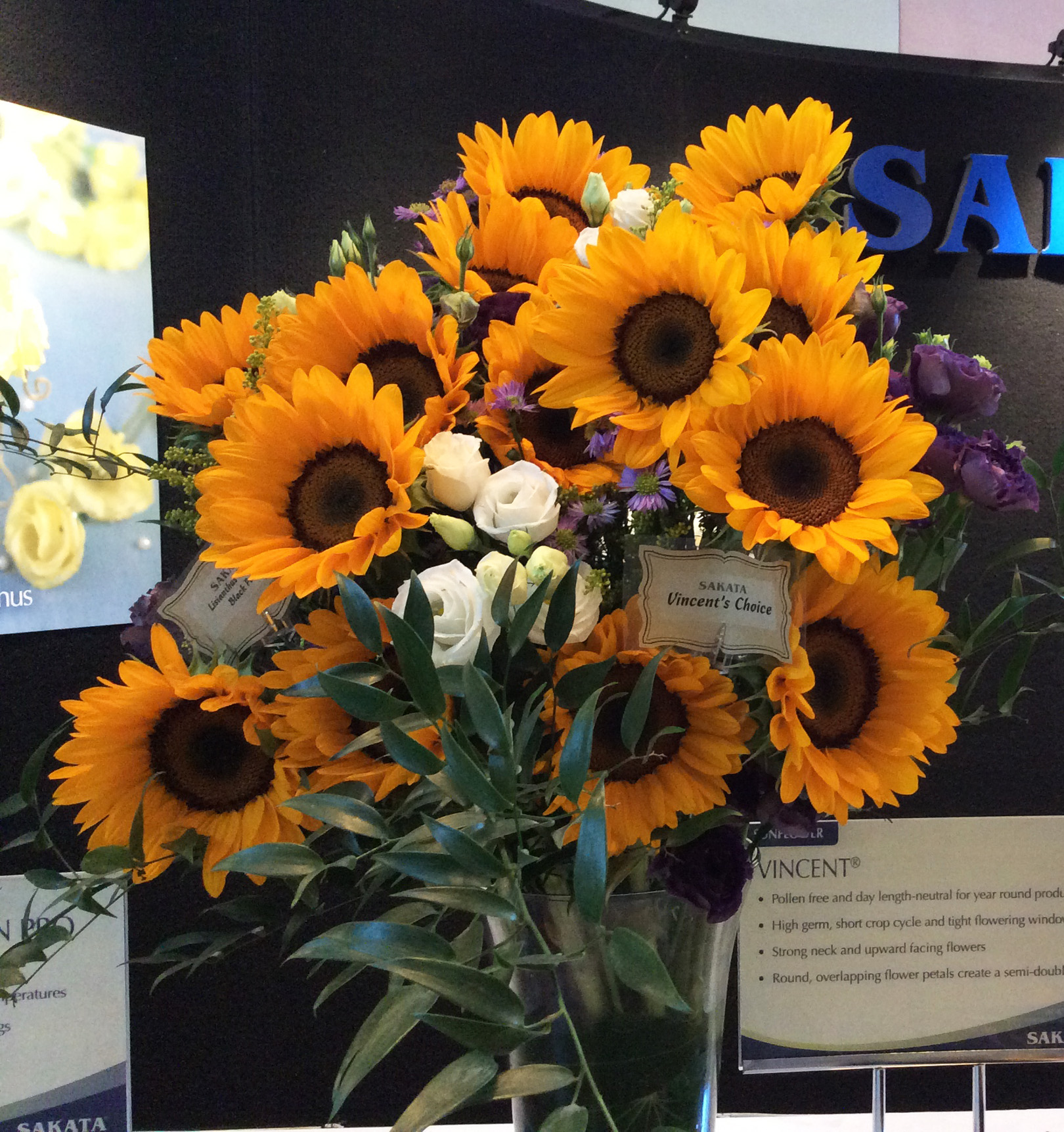 Sunflowers (Helianthus Vincent Choice) in combination with lisianthus (Eustoma grandifloruim ‘Black Pearl’ and ‘Rosanne’) make a luscious combination in a vase. Plant lust hit again…
Sunflowers (Helianthus Vincent Choice) in combination with lisianthus (Eustoma grandifloruim ‘Black Pearl’ and ‘Rosanne’) make a luscious combination in a vase. Plant lust hit again…
Talented designers compete in several categories. One category is: here is your plant, create an arrangement around it for a center piece, a mantlepiece or a bridal bouquet. The plant this year was one of the tender hen and chicks (Echeveria hybrid). This is not your grandmother’s bridal bouquet.
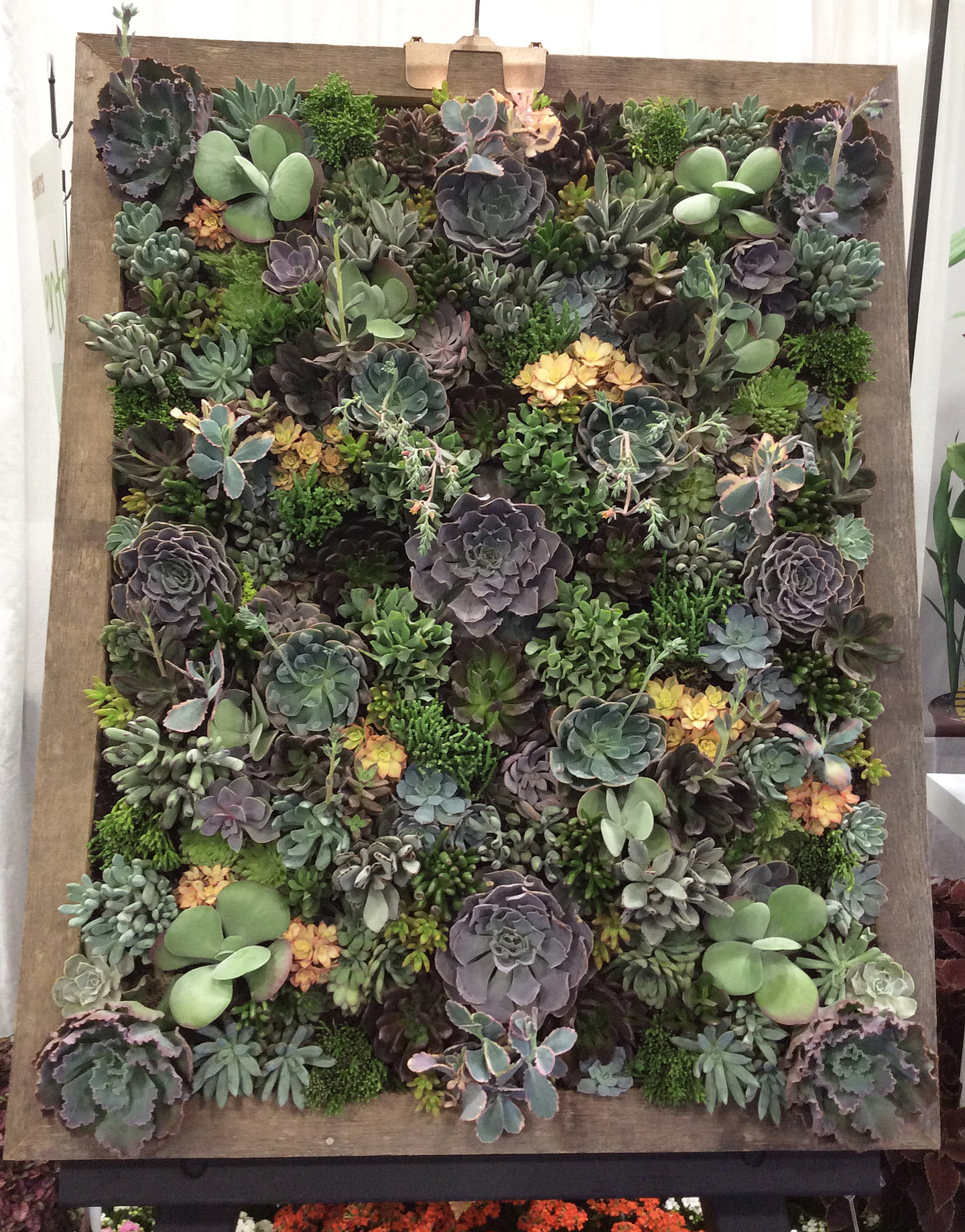 Carrying on our current love affair with succulents in the home and garden, many framed displays of succulents were scattered around the trade show. This “picture” was one of three set up along one of the primary cross-paths in the show. I was trying to think where a four by four foot display would fit in my living room.
Carrying on our current love affair with succulents in the home and garden, many framed displays of succulents were scattered around the trade show. This “picture” was one of three set up along one of the primary cross-paths in the show. I was trying to think where a four by four foot display would fit in my living room.
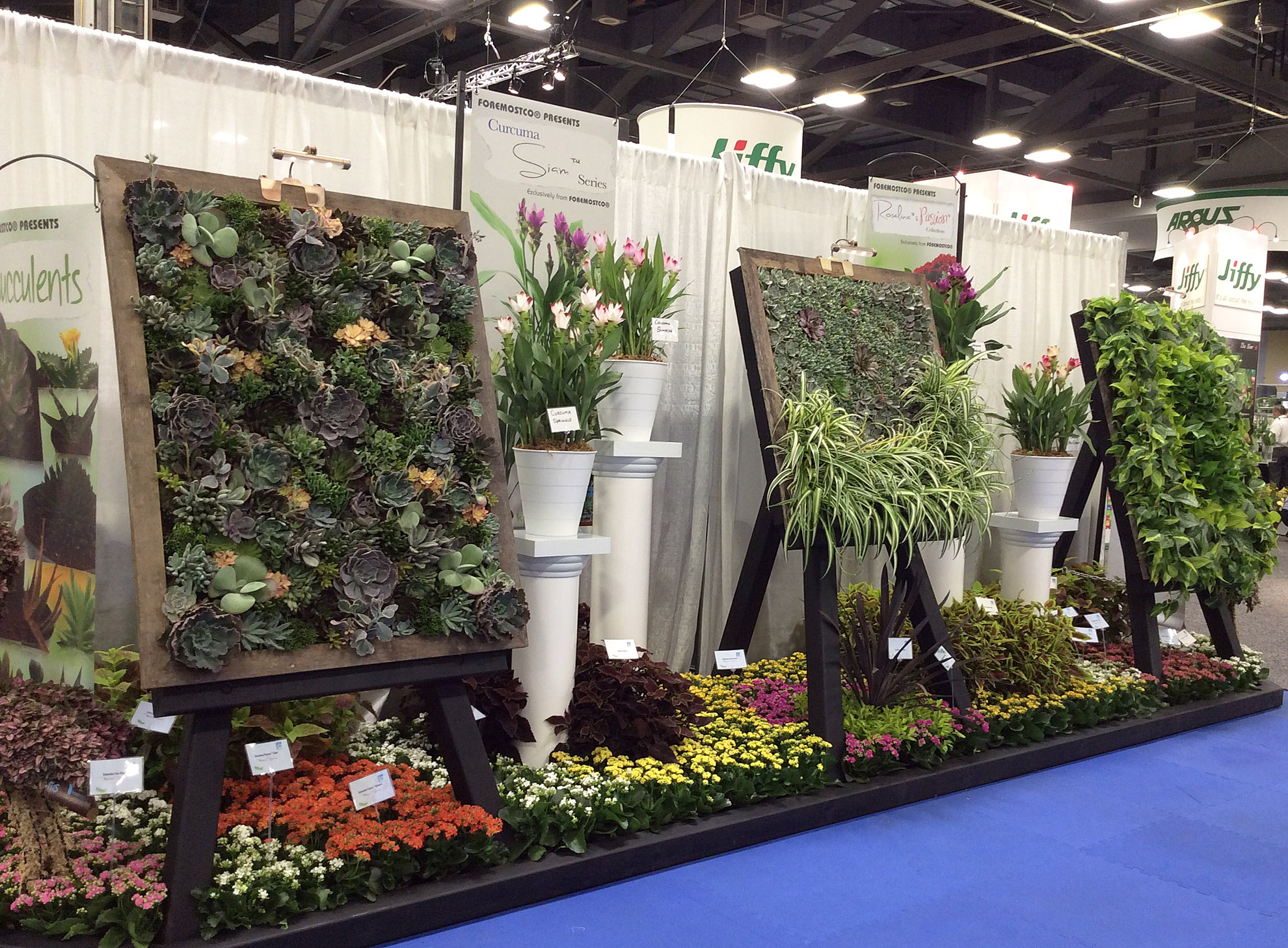 The other two easels were mixes of succulents, grasses and ferns. Note the potted plants close to the center of the picture. These turmeric plants (Curcuma hybrid) were selected for their gorgeous flowers. I grew turmeric years ago thinking that I would harvest and dry the rhizome for use in the kitchen. The flowers were beautiful, but not as free-flowering as the new hybrids. Note to self: another plant that will be grown next season.
The other two easels were mixes of succulents, grasses and ferns. Note the potted plants close to the center of the picture. These turmeric plants (Curcuma hybrid) were selected for their gorgeous flowers. I grew turmeric years ago thinking that I would harvest and dry the rhizome for use in the kitchen. The flowers were beautiful, but not as free-flowering as the new hybrids. Note to self: another plant that will be grown next season.
Proven Winners sets up booths that showed how their plants could be used on decks and porches. While you might not want as many plants in the above two “idea rooms”, it definitely makes you think of fall display possibilities; and then, there is next year…
Lastly, here is the perfect garden: buy everything in bloom, arrange, plant, add water, and sit back and enjoy with a glass of wine in hand.
Stay tuned for Part 2.
by GardenLover | May 24, 2016 | Favorite Flora, Gardens to Drive
Pollinators and Plants for Pollinator-Friendly Gardens – Part 2
By Debra Knapke
Last week, I introduced you to the pollinators in Part 1. Now, it’s time for the pollinator plants . . .
Let’s start with general plant groups and work toward some specific choices in each group. This is a start. Any plant that is not wind-pollinated has an associated pollinator. Once you start exploring your plant options, the sky is the limit.
Aster family
Most members of this family provide a perfect perch for many insects. You will see an array of bugs, beetles, flies, bees, wasps and spiders crawling on the composite daisy flowers (Note: spiders are actually looking for their next meal; it’s a bug-eat-bug world out there!).
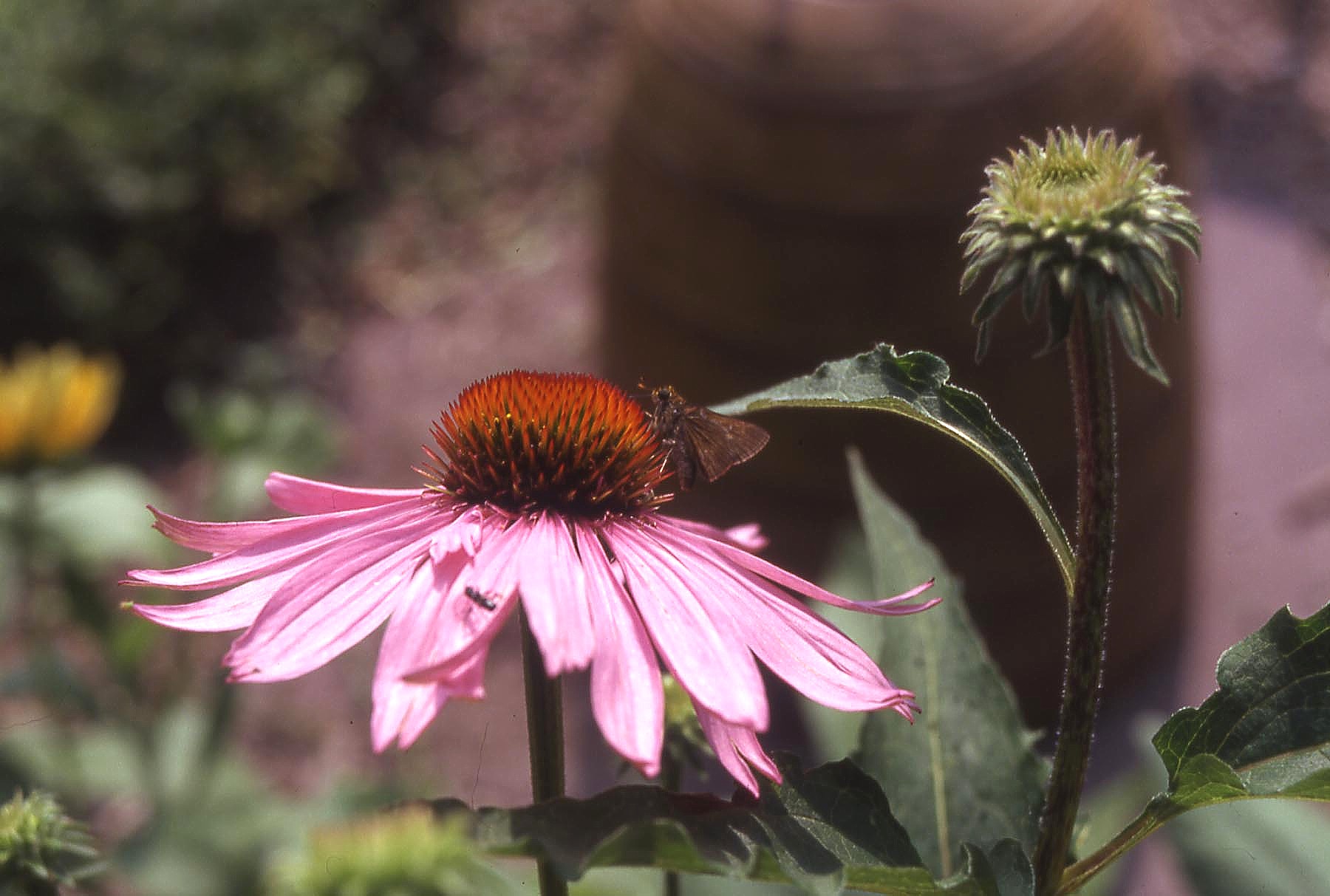
Echinacea purpurea — purple coneflower, plus a skipper
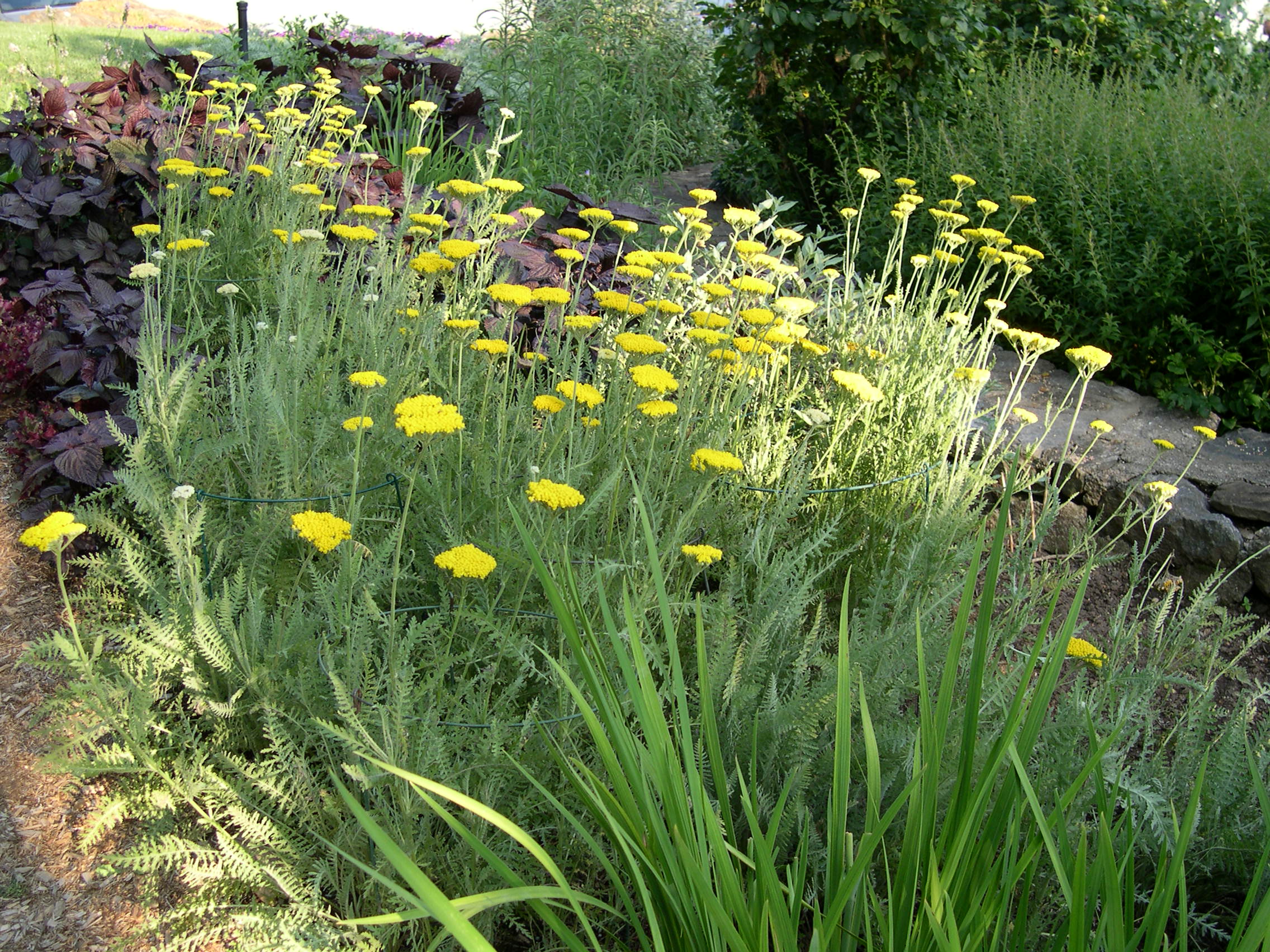
Achillea filipendulina – yarrow; a full sun plant!
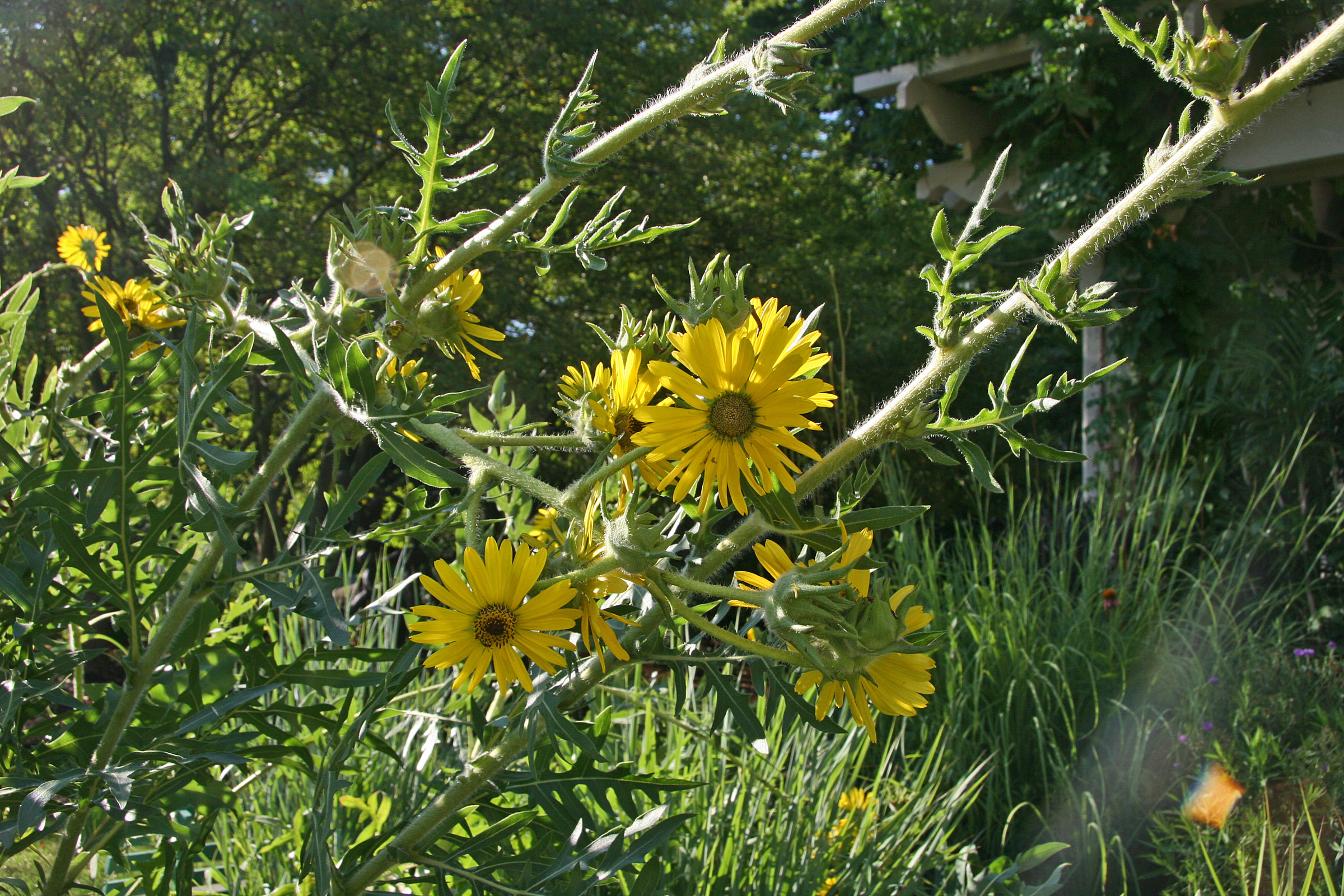
Silphium laciniatum – compass plant, a stately native
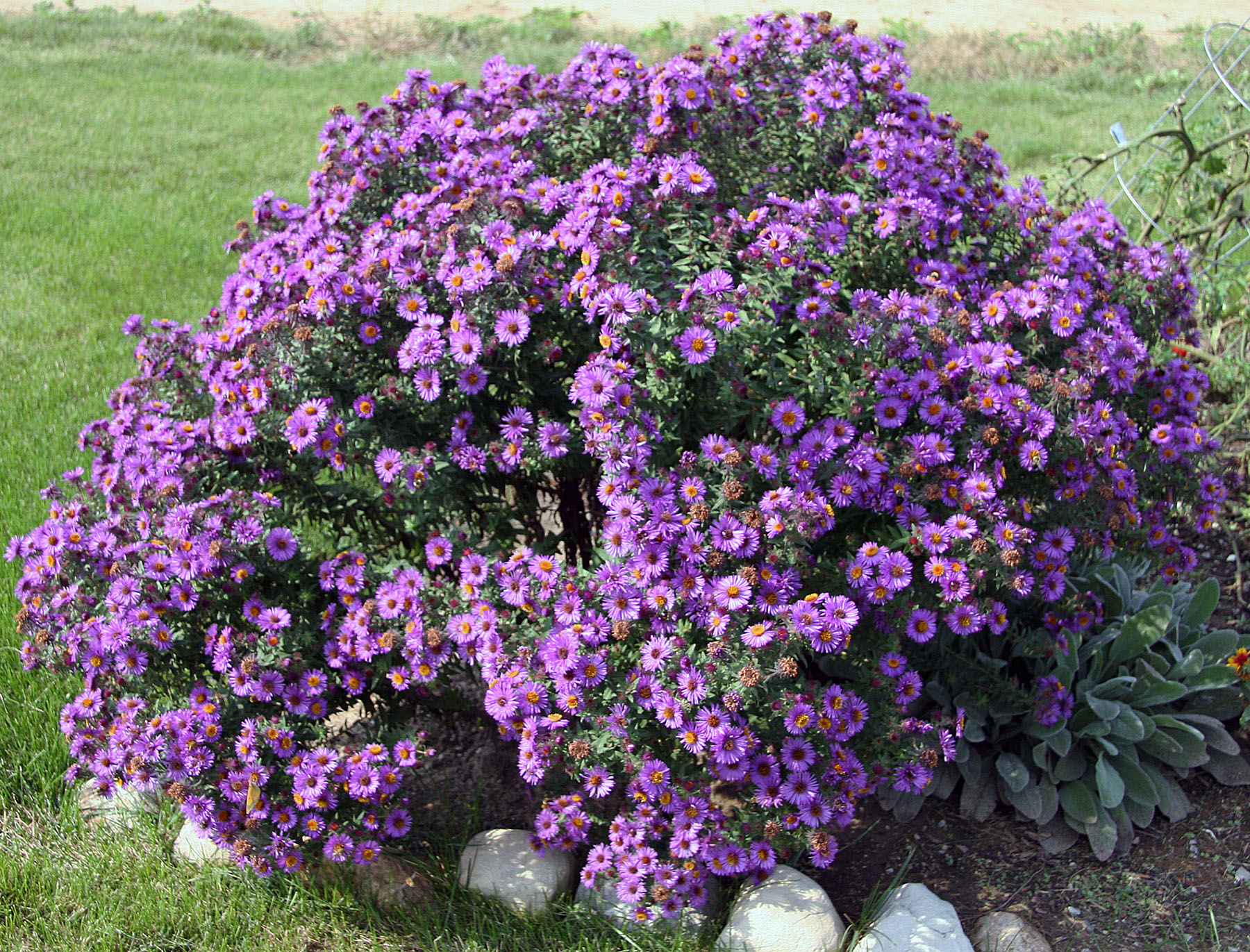
Symphyotrichum novae-angliae ‘Purple Dome’ – one of the last flowers for butterflies & other pollinators
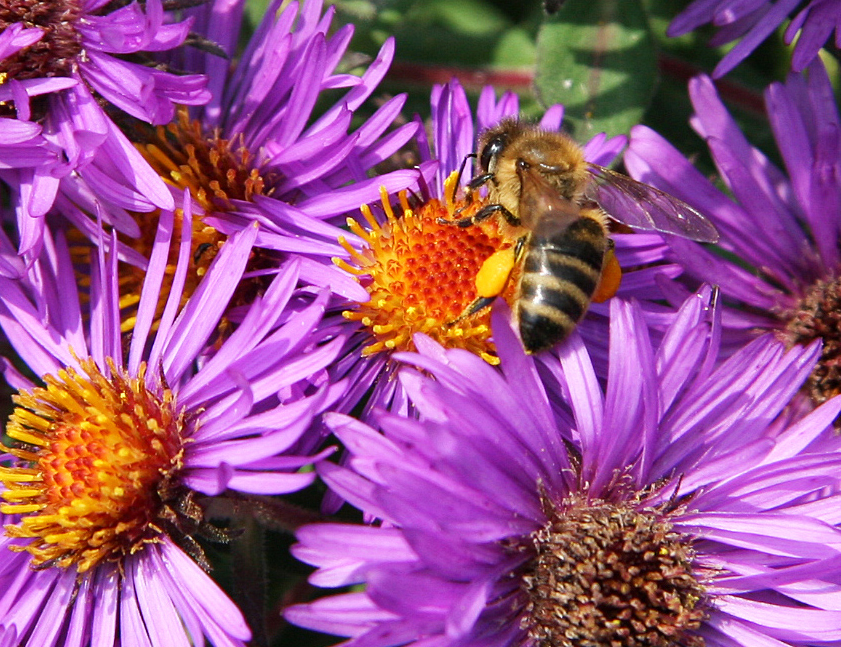
In October, a honeybee sips a late drink from a ‘Purple Dome.’
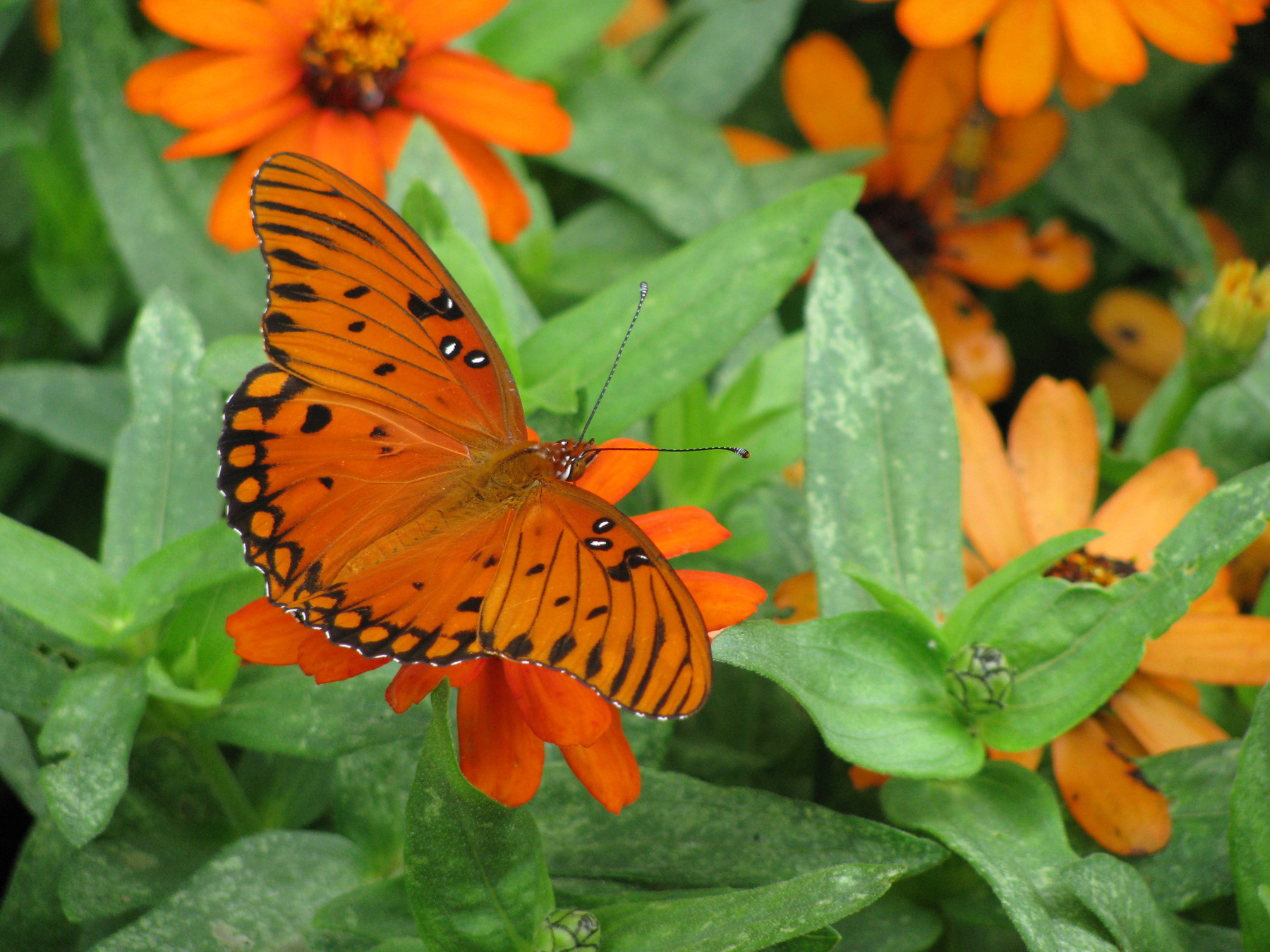
Zinnia angustifolia ‘Orange Profusion’– narrowleaf zinnia is an annual that is a pollinator magnet.
Bean/Pea family
Not only do the bumbles and other bees like the pea and bean family, but this group of plants has a lovely relationship with several species of bacteria that can fix gaseous nitrogen into a form that can be used by plants. Nitrogen is often the most limiting nutrient in built landscapes. This plant offers a way to fix the problem.
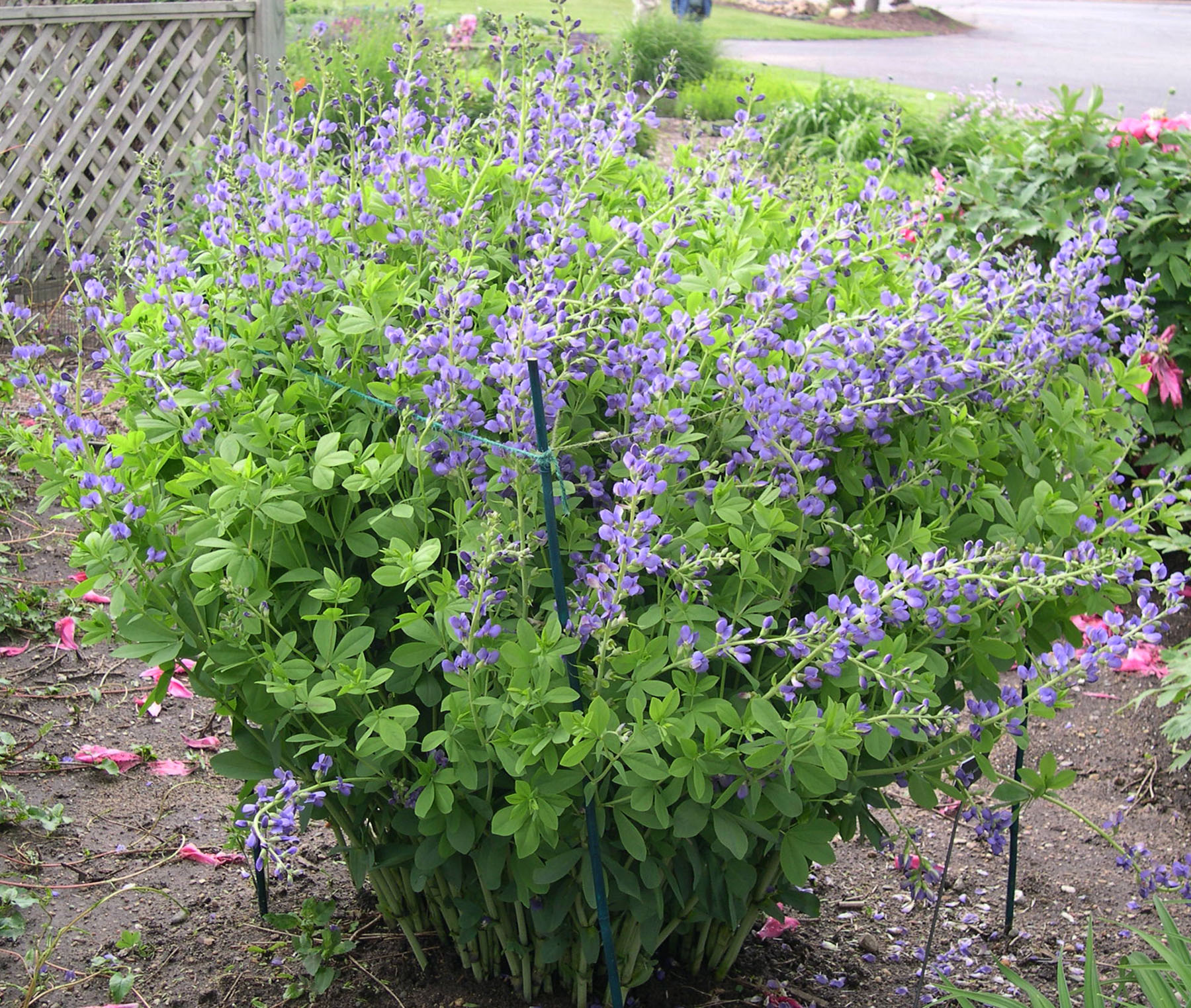
Baptisia australis – false indigo – is one of the most enduring plants in the garden.
Milkweed family
We have many species of milkweeds and butterflyweeds that are native to the Midwest. A recent study found that swamp milkweed (Asclepias incarnata) is the most likely to be chosen by the monarch butterfly as a larval host in the Midwest. The Mexican tropical milkweed – Asclepias curassavica – is the host plant for the monarch when it travels south for the winter.
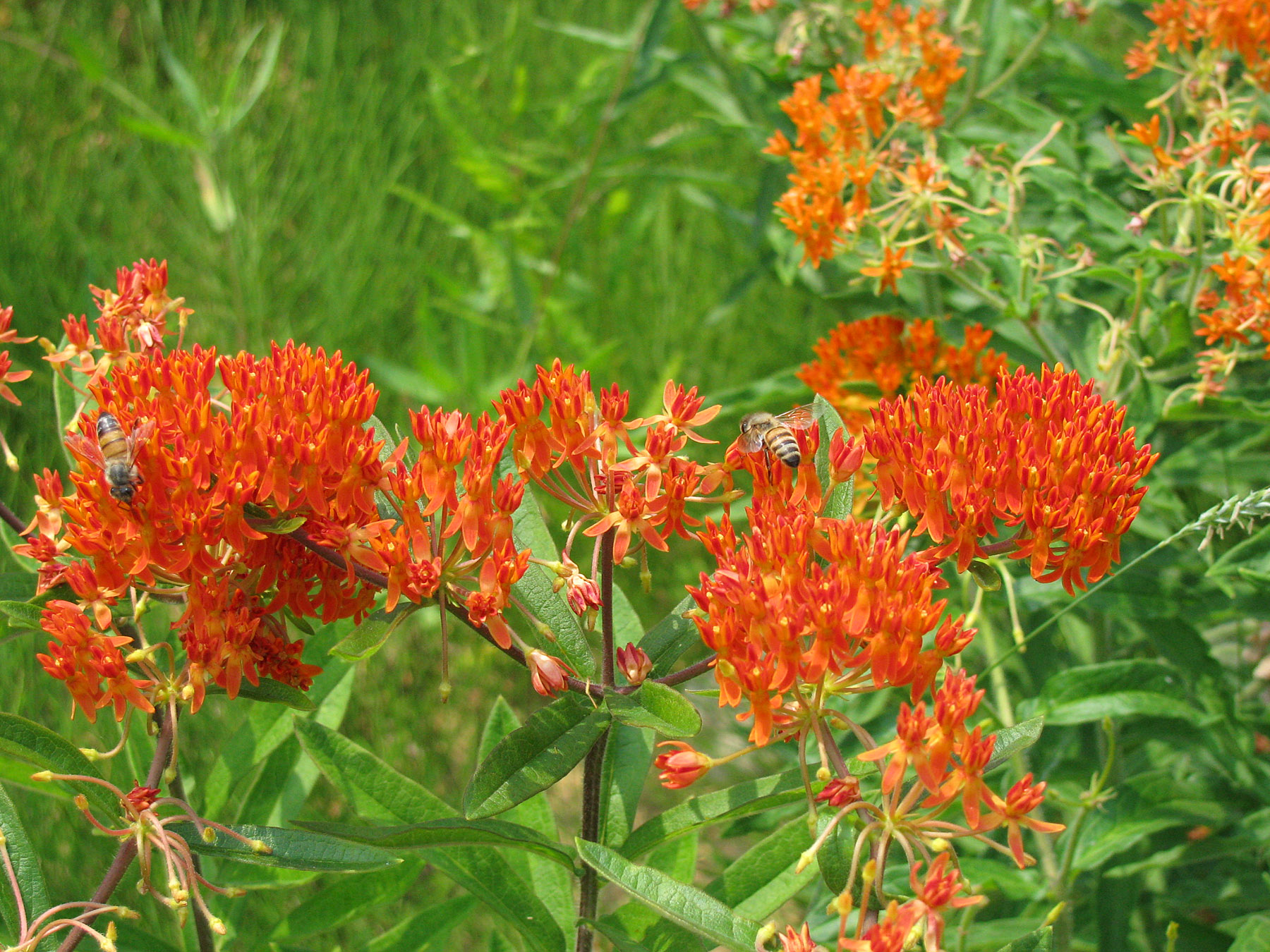
Asclepias tuberosa – butterflyweed for butterflies and bees
Mint family
Species in this herbal family should be in every garden. Many of the species are our favorite culinary herbs (basil, mint, oregano, rosemary, sage, thyme…) and many have anti-fungal, anti-bacterial attributes. The bilabiate flowers have long throats that lead to the nectaries. I have watched bumbles chew into the base of the flower because they could not enter the flower through the “front door.”
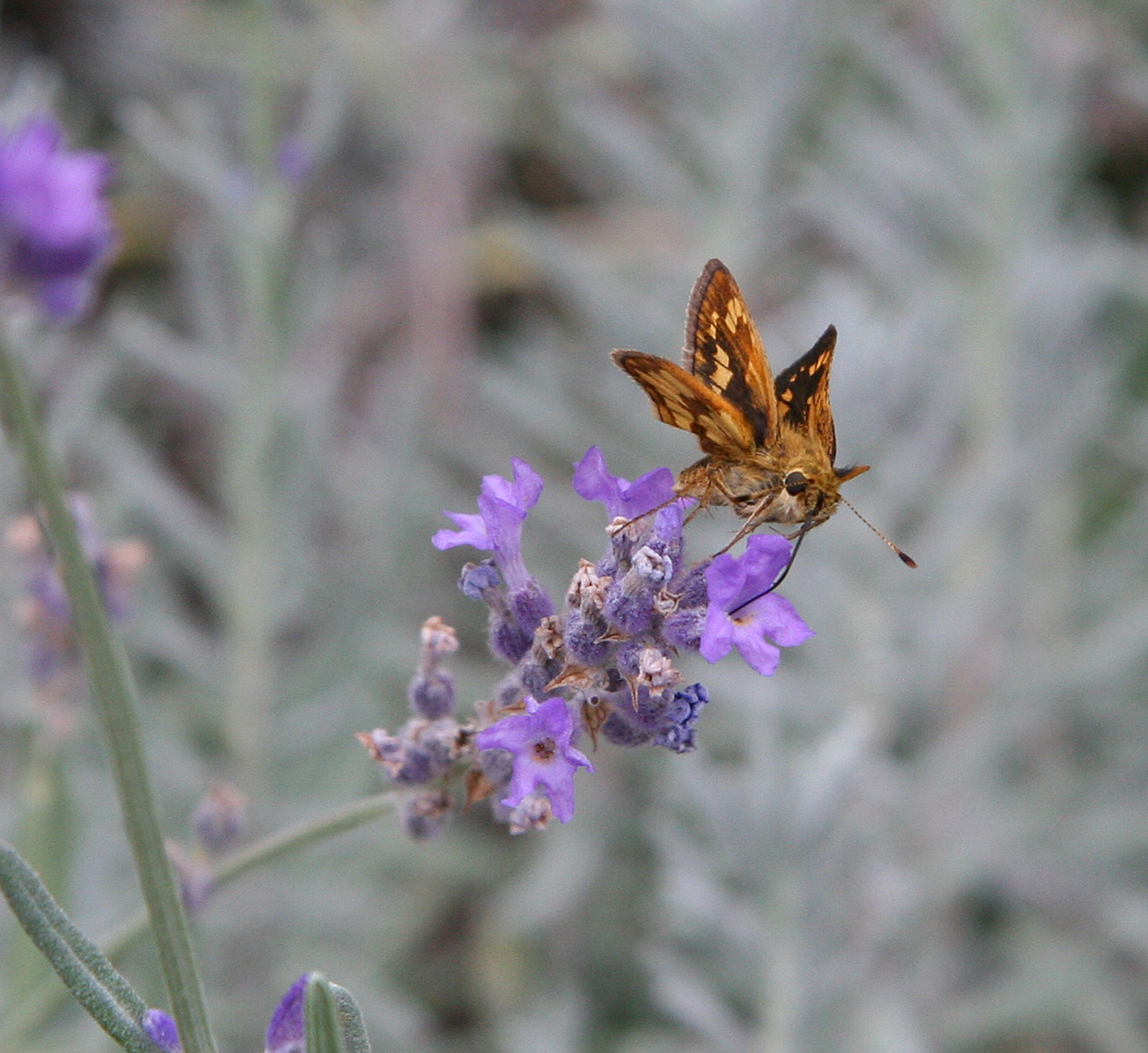
Lavandula angustifolia – English lavender with skipper
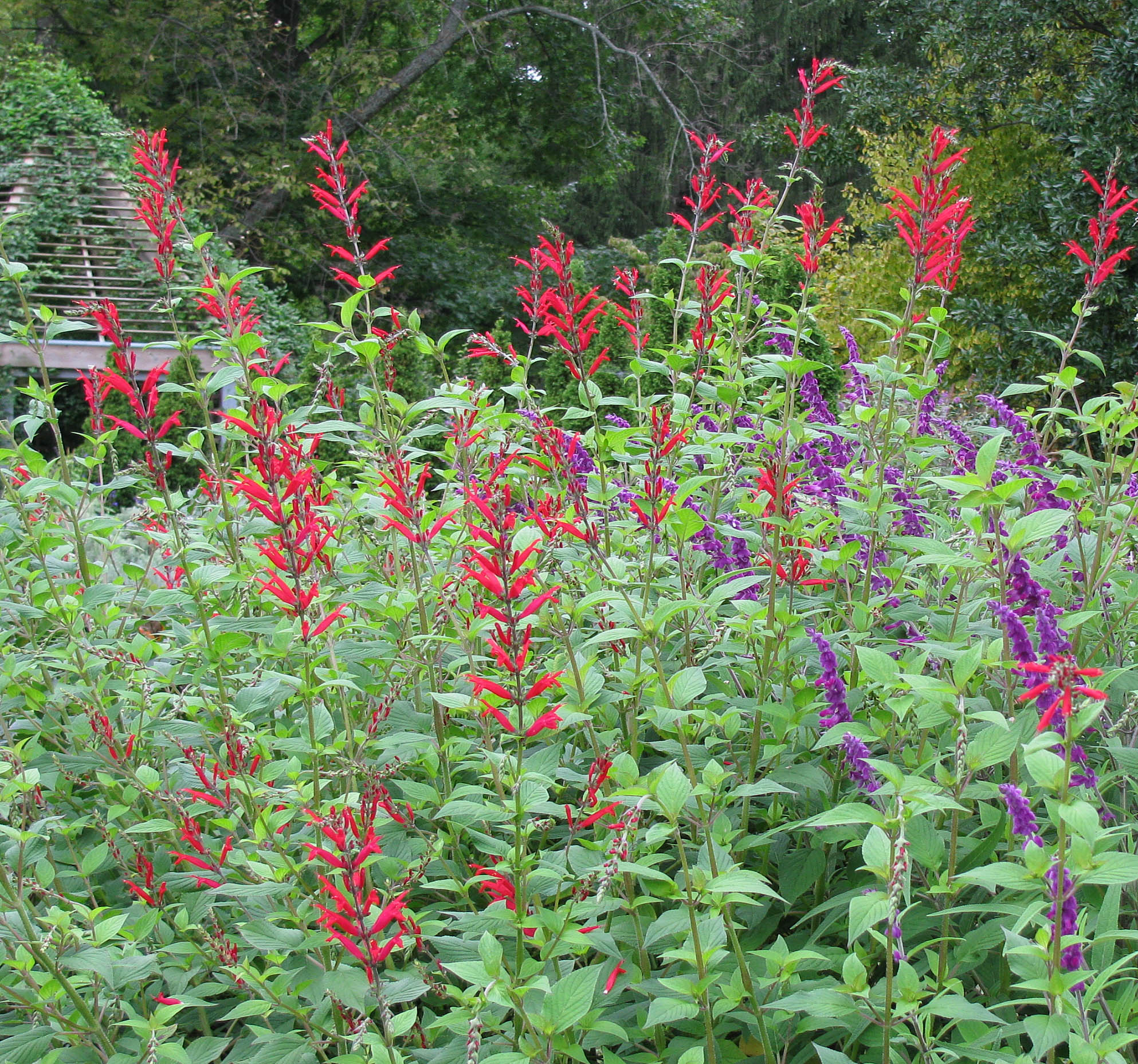
Salvia elegans (red, pineapple sage) and Salvia leucantha (blue, Mexican bush sage) are hummingbird dream-plants. I have been “strafed” in the garden by hummingbirds when I have stood in the flight path to the flowers.
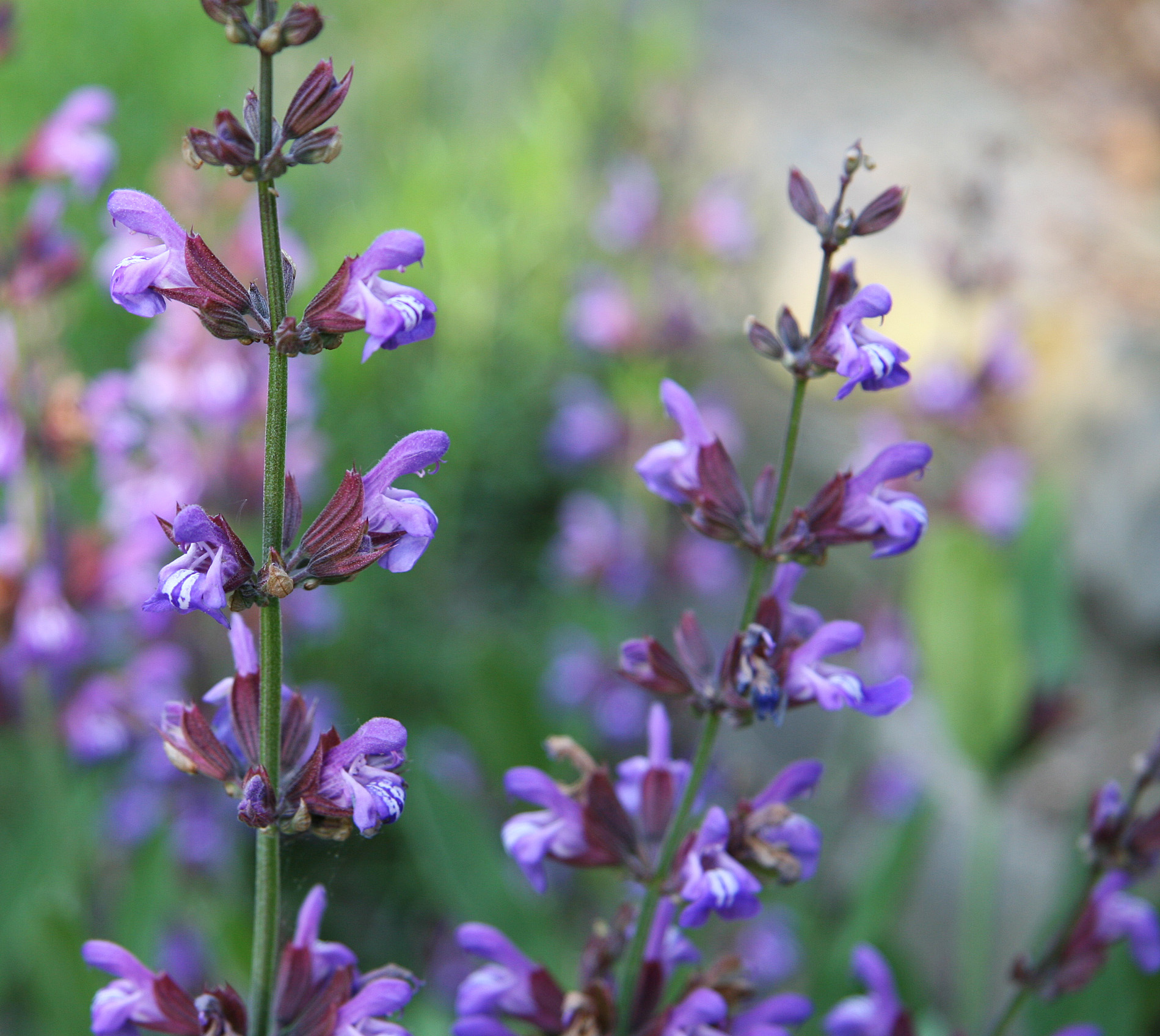
Salvia officinalis – common sage which is tasty and beautiful.
Parsley/Celery family
Another family that contains many herbal plants and some of our most potent poisons, not only feeds pollinators but also attracts the “good” bugs that eat the “bad” bugs – at least from the human perspective.
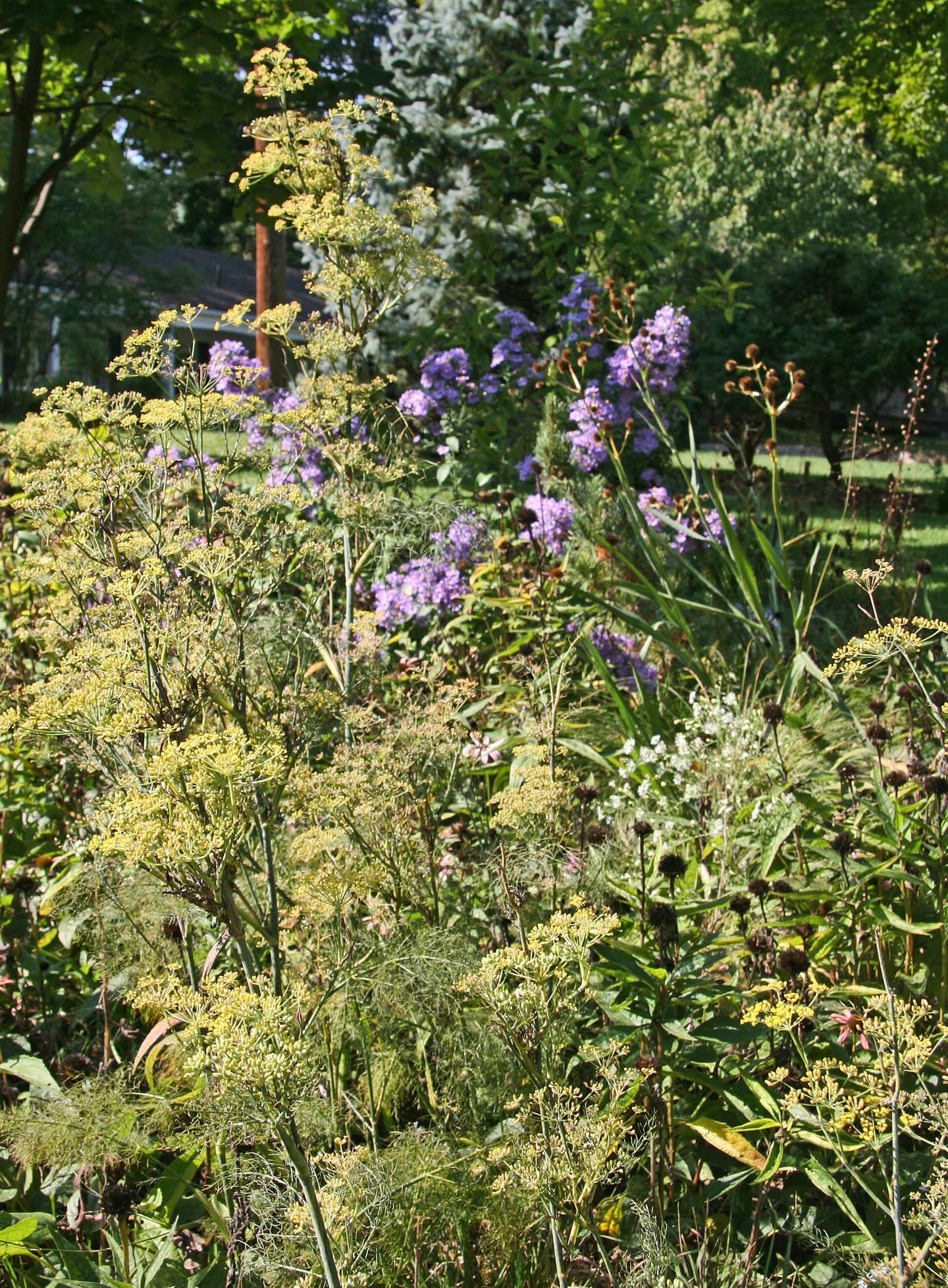
Foeniculum vulgare ‘Purpureum’ – bronze fennel is another multi-tasker in the garden. It is a culinary and medicinal plant. It hosts a variety of butterfly larvae while offering pollen and nectar to many insects.
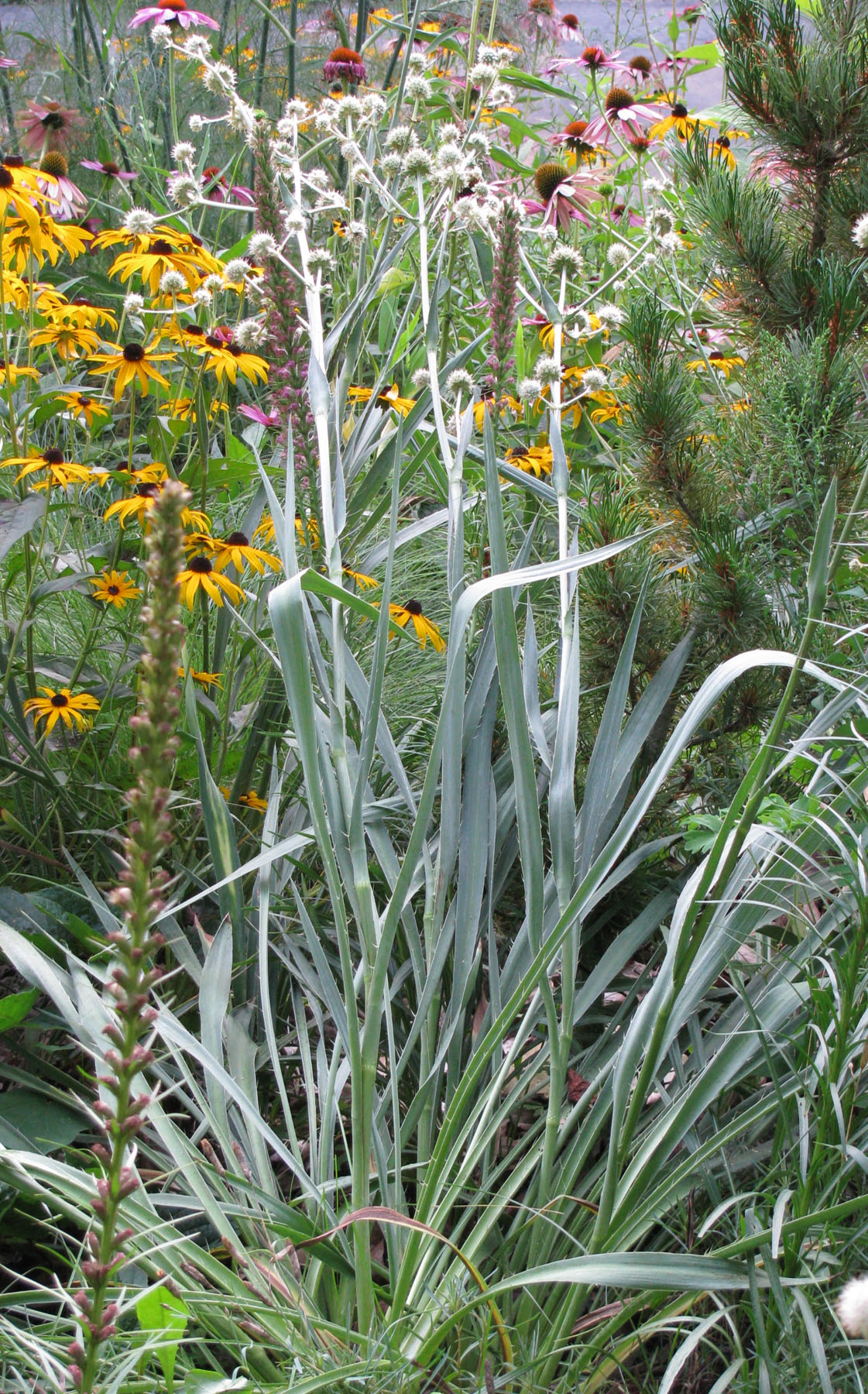
Eryngium yuccifolium – rattlesnake master – a tea made from its roots is reputed to be an antidote for snake venom; not sure I would trust that. Its flowers attract a myriad of insects.
All of the above are herbaceous perennials, but many trees and shrubs provide food for pollinators, too. Below is a bumble on her way to becoming drunk from the flowers of a littleleaf linden tree – Tilia cordata.
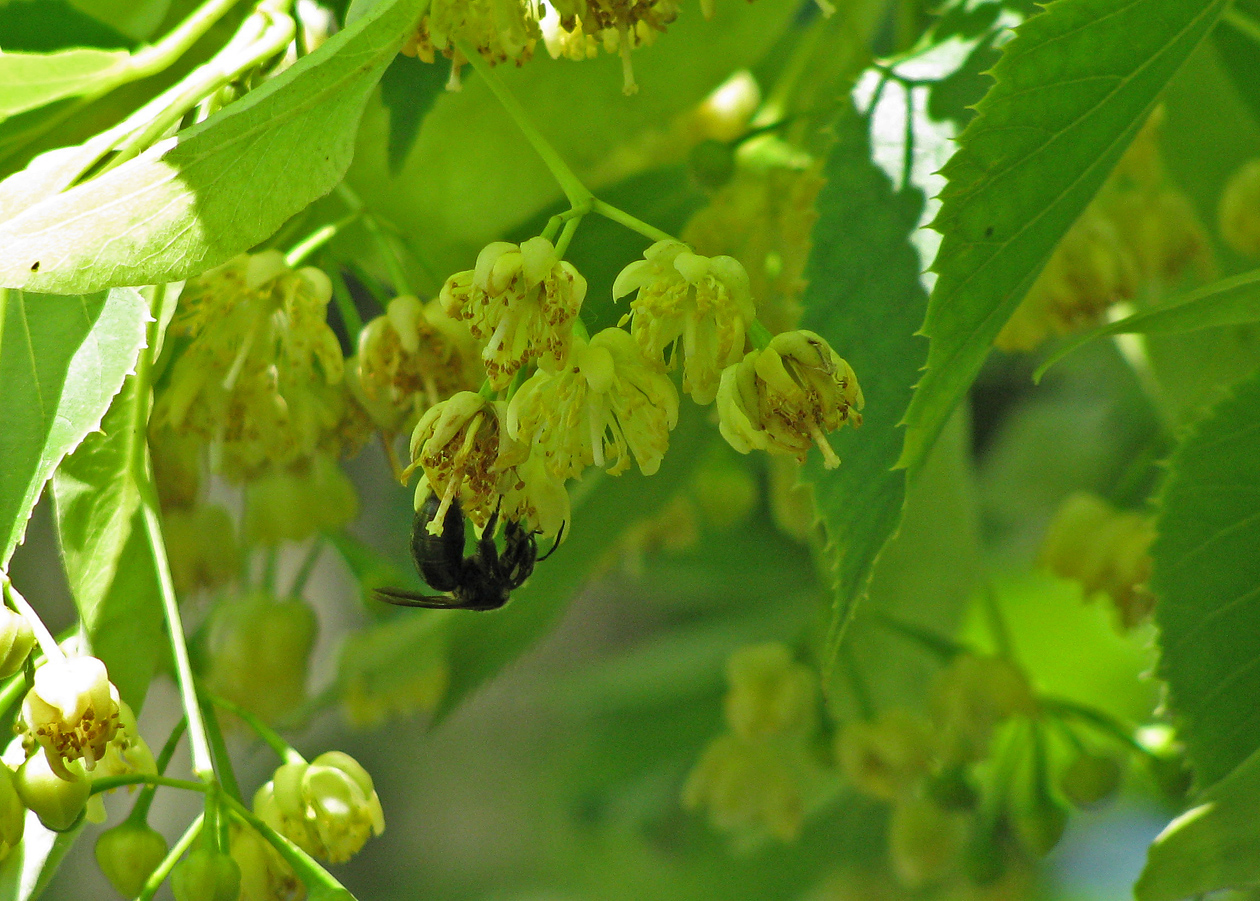
Wishing you awe in the garden!!!
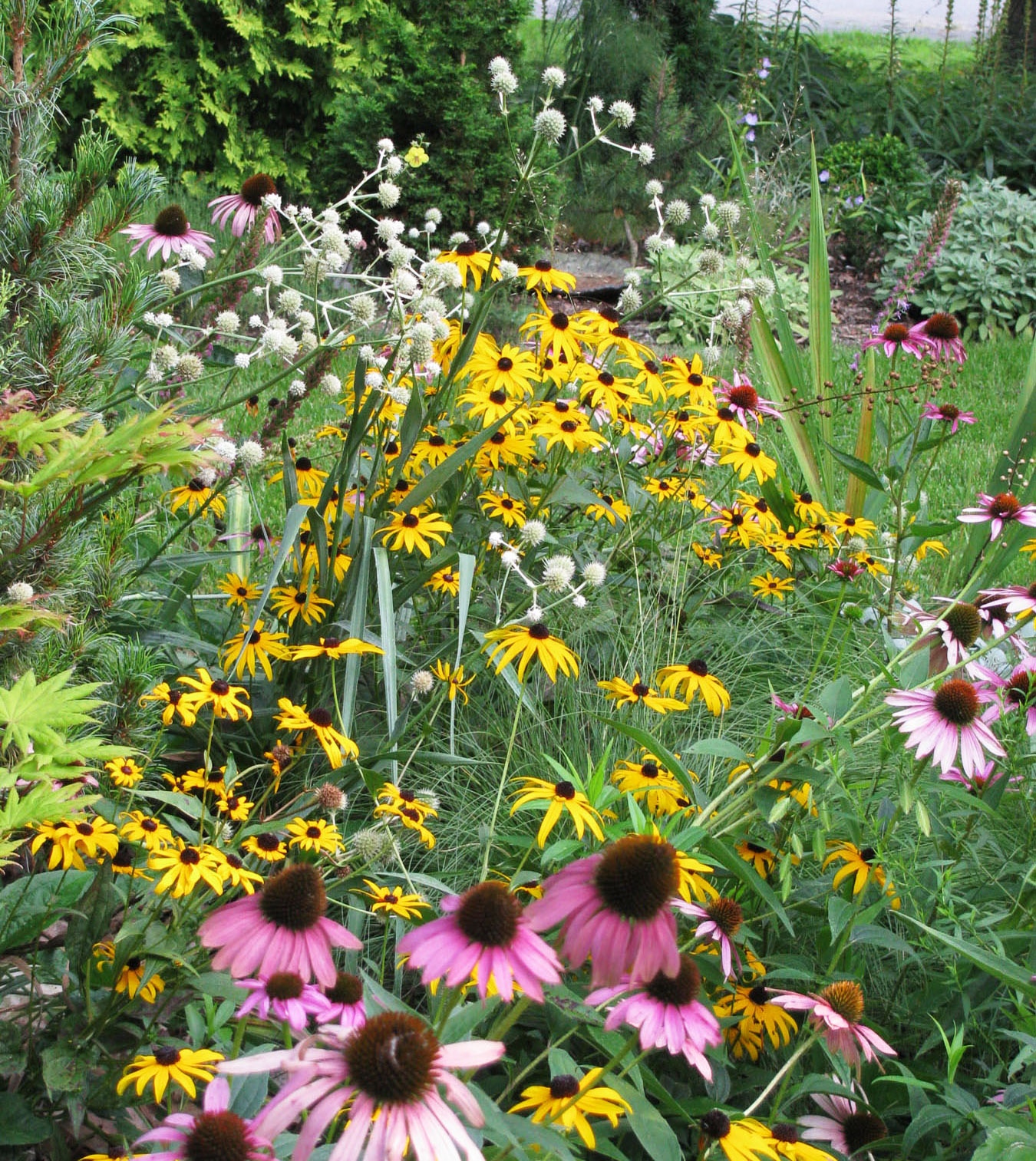
by GardenLover | May 18, 2016 | Favorite Flora
Pollinators and Plants for Pollinator-Friendly Gardens – Part 1
By Debra Knapke
Pollinators and plants: a beautiful symbiotic relationship that is usually mutually beneficial. A plant gets to propagate itself, while the pollinator gets food. We’ve always known that these relationships exist, but there are threats that are interfering with plant and pollinator interactions. Global Climate Change, habitat reduction, and pesticide use are just a few.
We can be part of the solution. Resist using pesticides in the garden and let the “good” bugs have a chance to eat the “bad” bugs. Buy more plants and create pollinator habitats in your garden.
In order to choose which plants, you need to know who you are inviting in.
Meet the pollinators:
Bees
In the June/July 2016 National Wildlife magazine it was reported that bees contribute $300 billion toward global agricultural systems. We are fortunate to have a diverse group of native bees in the Midwest. If you are interested in learning more about identification and good landscape practices for supporting our native bees, check out the resources at the
Ohio State University Bee Lab website.
The non-native, but very important honeybee will benefit from the same plants and practices that you would use for our native bees. This is a case where native/non-native is a non-issue. Both native and non-native bees are essential to our well-being.
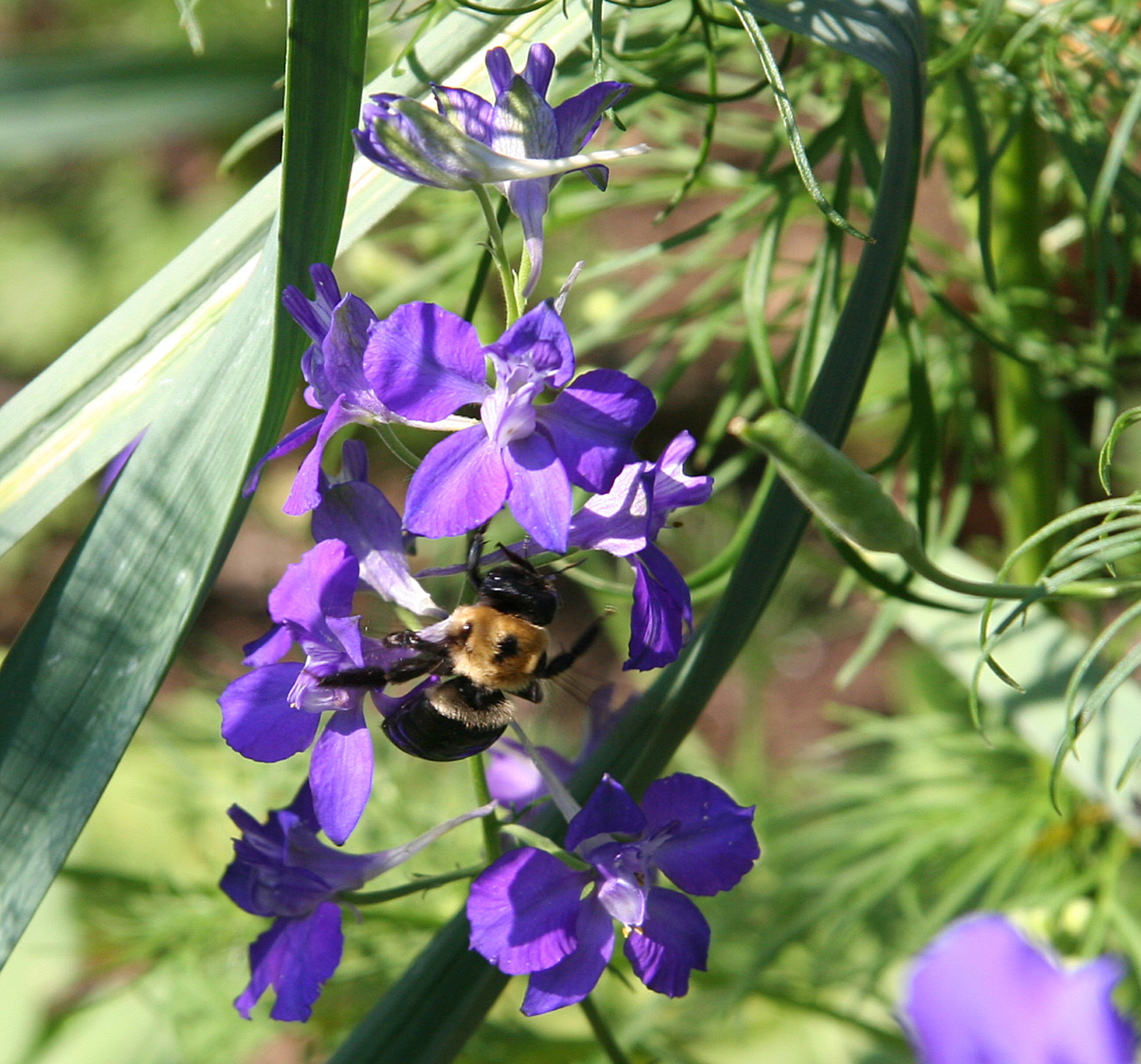
Bumblebee on annual larkspur
Flies
Some of the bees you see are actually flies; often called Hover flies or Syrphid flies. A bonus of this pollinator group is that the larval stage is a voracious eater of aphids.
How can you tell bees and flies apart? A quick way is to note the number of wings: bees have two pairs; flies have one pair.
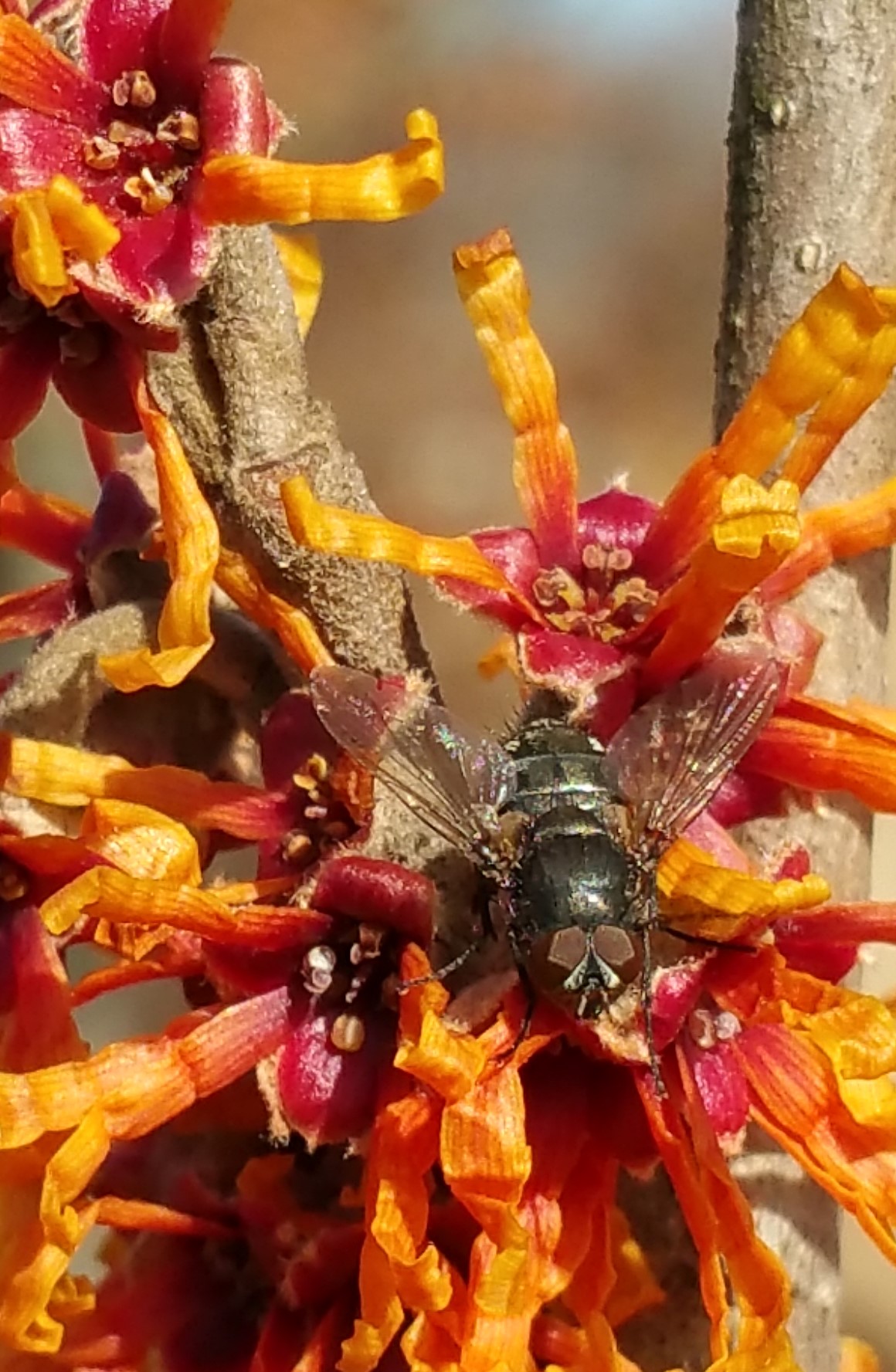
Fly on witch hazel
Sometimes we do not give flies their due in the insect world. I would like to offer this thought: without a small tropical fly, we would not have chocolate.
Hummingbirds
This flying jewel is particularly fond of deep-throated flowers. They typically live in the Midwest from the beginning of April to the beginning of October. On their quest for nectar, they also transfer pollen between flowers.
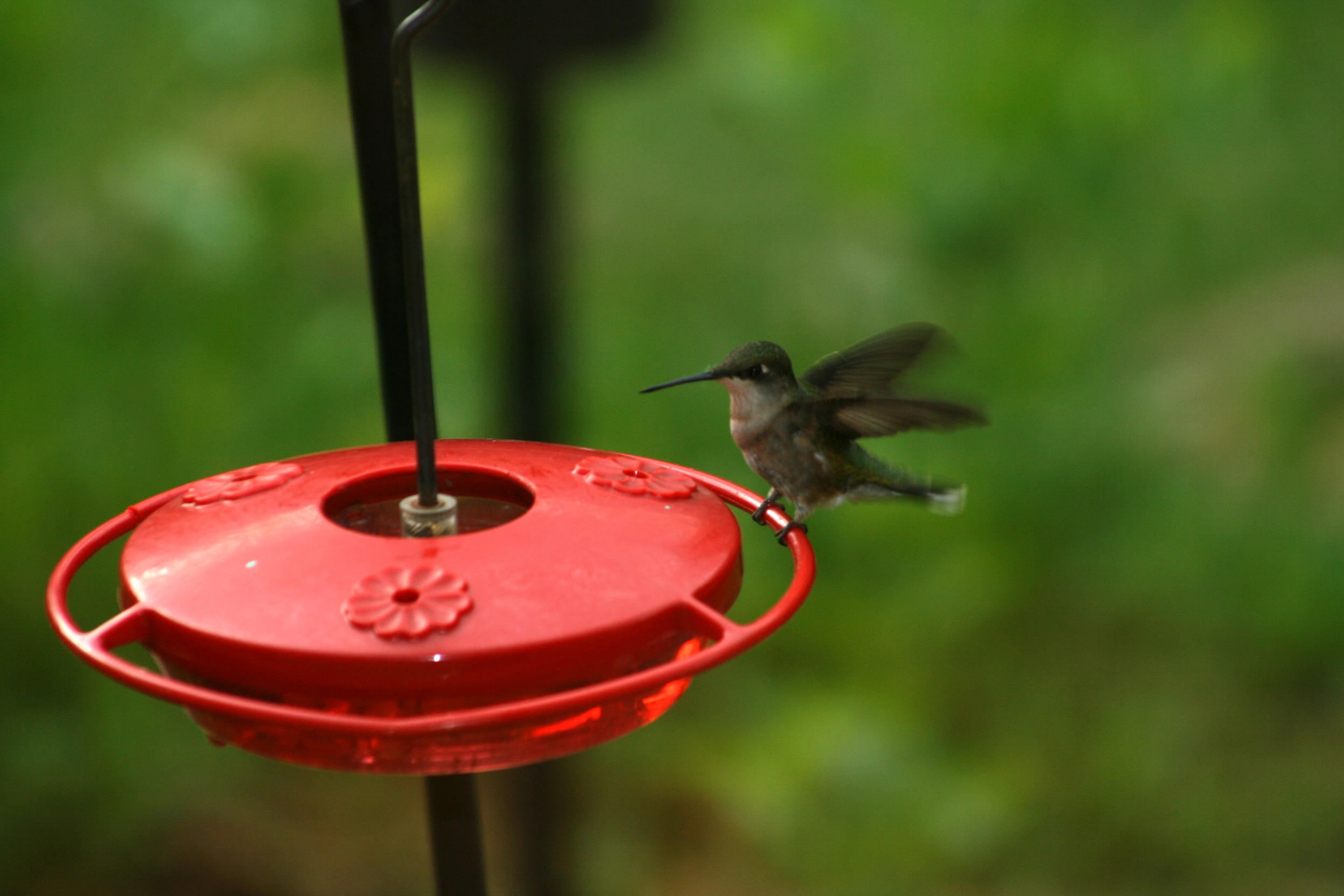
Butterflies, Skippers and Moths
Monarchs have been the poster child for creating habitat for pollinators, but there are so many other butterflies, skippers and moths that benefit from a ready source of nectar and their required larval plants. Some pollinators are night visitors. A moon garden filled with night-blooming white and pale yellow flowered species offers food to night-flying moths.
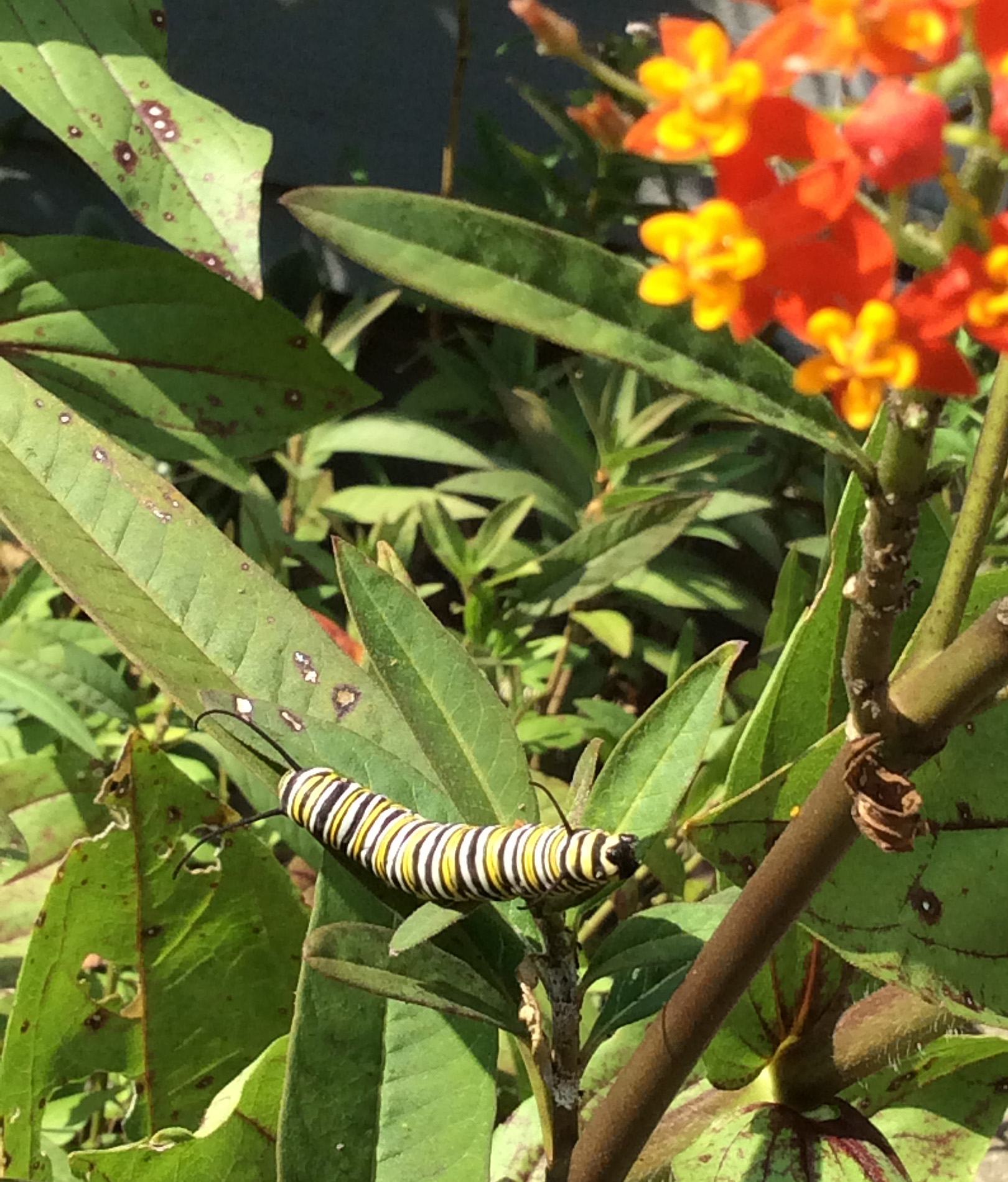
Asclepias curassavica — tropical milkweed — with monarch larvae
There are other pollinators, but this is not meant to be an exhaustive treatise. It is an introduction. Hopefully you will be intrigued enough to do some research of your own.
On Friday, look for my follow-up post on pollinators’ favorite plants.
by GardenLover | Sep 23, 2015 | Favorite Flora, Snapshots, Special Topic
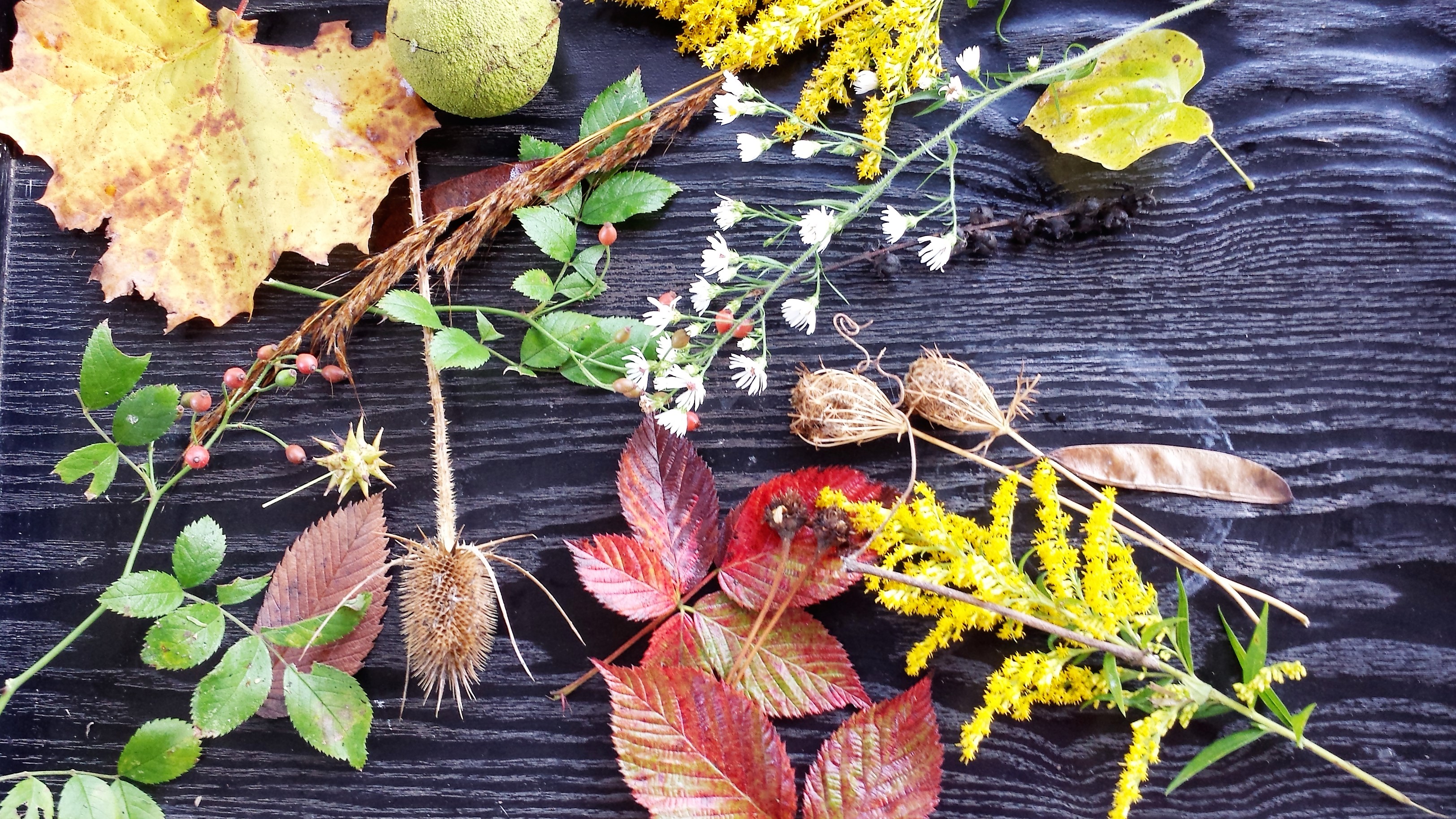 Looking for some fall gardening inspiration? Well, check out some of the season’s best posts on Heartland Gardening:
Looking for some fall gardening inspiration? Well, check out some of the season’s best posts on Heartland Gardening:







 Sages are among my favorite plants: gorgeous flowers, hummingbird and other pollinator attractors, herbal uses, and easy to grow. Above is one of the Brazilian sage species (Salvia guaranitica ‘Amistadt’). Its electric purple blooms call you from across the garden. An older sibling (below) is Black and Blue sage (Salvia guaranitica ‘Black and Blue’). When you grow this sage in your garden be prepared to be strafed by hummingbirds if you happen to be weeding when they wish to feed.
Sages are among my favorite plants: gorgeous flowers, hummingbird and other pollinator attractors, herbal uses, and easy to grow. Above is one of the Brazilian sage species (Salvia guaranitica ‘Amistadt’). Its electric purple blooms call you from across the garden. An older sibling (below) is Black and Blue sage (Salvia guaranitica ‘Black and Blue’). When you grow this sage in your garden be prepared to be strafed by hummingbirds if you happen to be weeding when they wish to feed.
 From time the time, the experts are stumped. This lovely little annual had many of us asking: “What is this?” When we found a docent who had the plant list and learned that we were looking at a large-flowered laurentia (Isotoma axillaris ‘Avant Garde White’), there were more than a few sheepish expressions. The flowers were approximately 1.5” in diameter – they are usually much smaller – and they danced in the breeze. And, another plant goes on the list for next year!
From time the time, the experts are stumped. This lovely little annual had many of us asking: “What is this?” When we found a docent who had the plant list and learned that we were looking at a large-flowered laurentia (Isotoma axillaris ‘Avant Garde White’), there were more than a few sheepish expressions. The flowers were approximately 1.5” in diameter – they are usually much smaller – and they danced in the breeze. And, another plant goes on the list for next year! Alliums are another useful plant in the garden. One downside is their excessive seeding. After three to four years, you may have only alliums in your garden. Enter some of the new hybrids that make few to no fertile seeds. Pink Planet allium (above) is one of those new hybrids; Millennium is another – Millennium allium is now in my garden. I will let you know about its fecundity.
Alliums are another useful plant in the garden. One downside is their excessive seeding. After three to four years, you may have only alliums in your garden. Enter some of the new hybrids that make few to no fertile seeds. Pink Planet allium (above) is one of those new hybrids; Millennium is another – Millennium allium is now in my garden. I will let you know about its fecundity. At Kelly and Kelly Nursery, we saw what patience and vision can achieve. Need a fence? Create a ginkgo espalier. If you start this project now, you can have this in 10 to 15 years, or so.
At Kelly and Kelly Nursery, we saw what patience and vision can achieve. Need a fence? Create a ginkgo espalier. If you start this project now, you can have this in 10 to 15 years, or so. I would be remiss if I didn’t include a picture from the edible garden at the Minnesota Landscape Arboretum. If you are looking for the tastiest crabapple for jams and jellies then Dolgo crabapple (Malus ‘Dolgo’) is your tree. What is the only difference between a crabapple and an apple? The diameter of a crabapple is two inches or less; an apple is larger than two inches.
I would be remiss if I didn’t include a picture from the edible garden at the Minnesota Landscape Arboretum. If you are looking for the tastiest crabapple for jams and jellies then Dolgo crabapple (Malus ‘Dolgo’) is your tree. What is the only difference between a crabapple and an apple? The diameter of a crabapple is two inches or less; an apple is larger than two inches. Not all of the plants we see are in pots or gardens. The Minnesota Landscape Arboretum has an extensive collection of rare books in its library. This gorgeous lily was hand-colored and sold in limited folios to those who could afford books back in 1542 — 50 years after Columbus sailed the ocean blue. (De Historia Stirpium, Leonhart Fuchs, 1542)
Not all of the plants we see are in pots or gardens. The Minnesota Landscape Arboretum has an extensive collection of rare books in its library. This gorgeous lily was hand-colored and sold in limited folios to those who could afford books back in 1542 — 50 years after Columbus sailed the ocean blue. (De Historia Stirpium, Leonhart Fuchs, 1542) Plants are the designer’s medium. We use the tools of line, form, texture and color to create borders, beds and vignettes. We make places of order, activity, privacy and repose. Here is a border that is peaceful and textural in nature.
Plants are the designer’s medium. We use the tools of line, form, texture and color to create borders, beds and vignettes. We make places of order, activity, privacy and repose. Here is a border that is peaceful and textural in nature.
 Being a plant addict is not a hopeless condition. There are times when something other than a plant grabs my attention. This green tree frog nestled in a ligularia leaf may have been one of the most photographed garden visitors on the garden tour. Of course we were discussing the perfect color harmony of the reddish-brown markings on the frog with the veins on the leaf. Get a bunch of designers together and what do you get? Endless discussions of color, form and texture in the garden!
Being a plant addict is not a hopeless condition. There are times when something other than a plant grabs my attention. This green tree frog nestled in a ligularia leaf may have been one of the most photographed garden visitors on the garden tour. Of course we were discussing the perfect color harmony of the reddish-brown markings on the frog with the veins on the leaf. Get a bunch of designers together and what do you get? Endless discussions of color, form and texture in the garden!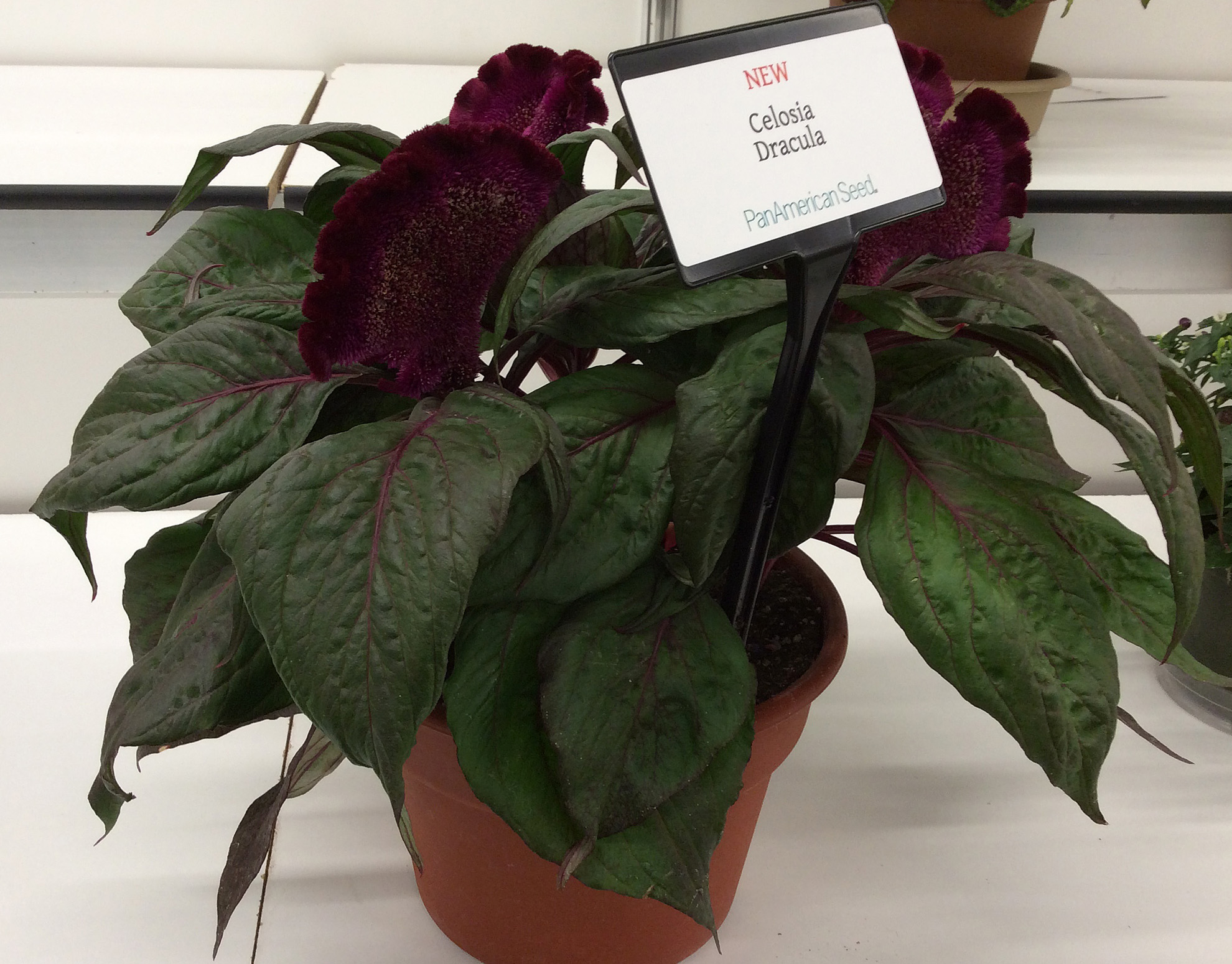

 Sunflowers (Helianthus Vincent Choice) in combination with lisianthus (Eustoma grandifloruim ‘Black Pearl’ and ‘Rosanne’) make a luscious combination in a vase. Plant lust hit again…
Sunflowers (Helianthus Vincent Choice) in combination with lisianthus (Eustoma grandifloruim ‘Black Pearl’ and ‘Rosanne’) make a luscious combination in a vase. Plant lust hit again… Carrying on our current love affair with succulents in the home and garden, many framed displays of succulents were scattered around the trade show. This “picture” was one of three set up along one of the primary cross-paths in the show. I was trying to think where a four by four foot display would fit in my living room.
Carrying on our current love affair with succulents in the home and garden, many framed displays of succulents were scattered around the trade show. This “picture” was one of three set up along one of the primary cross-paths in the show. I was trying to think where a four by four foot display would fit in my living room. The other two easels were mixes of succulents, grasses and ferns. Note the potted plants close to the center of the picture. These turmeric plants (Curcuma hybrid) were selected for their gorgeous flowers. I grew turmeric years ago thinking that I would harvest and dry the rhizome for use in the kitchen. The flowers were beautiful, but not as free-flowering as the new hybrids. Note to self: another plant that will be grown next season.
The other two easels were mixes of succulents, grasses and ferns. Note the potted plants close to the center of the picture. These turmeric plants (Curcuma hybrid) were selected for their gorgeous flowers. I grew turmeric years ago thinking that I would harvest and dry the rhizome for use in the kitchen. The flowers were beautiful, but not as free-flowering as the new hybrids. Note to self: another plant that will be grown next season.